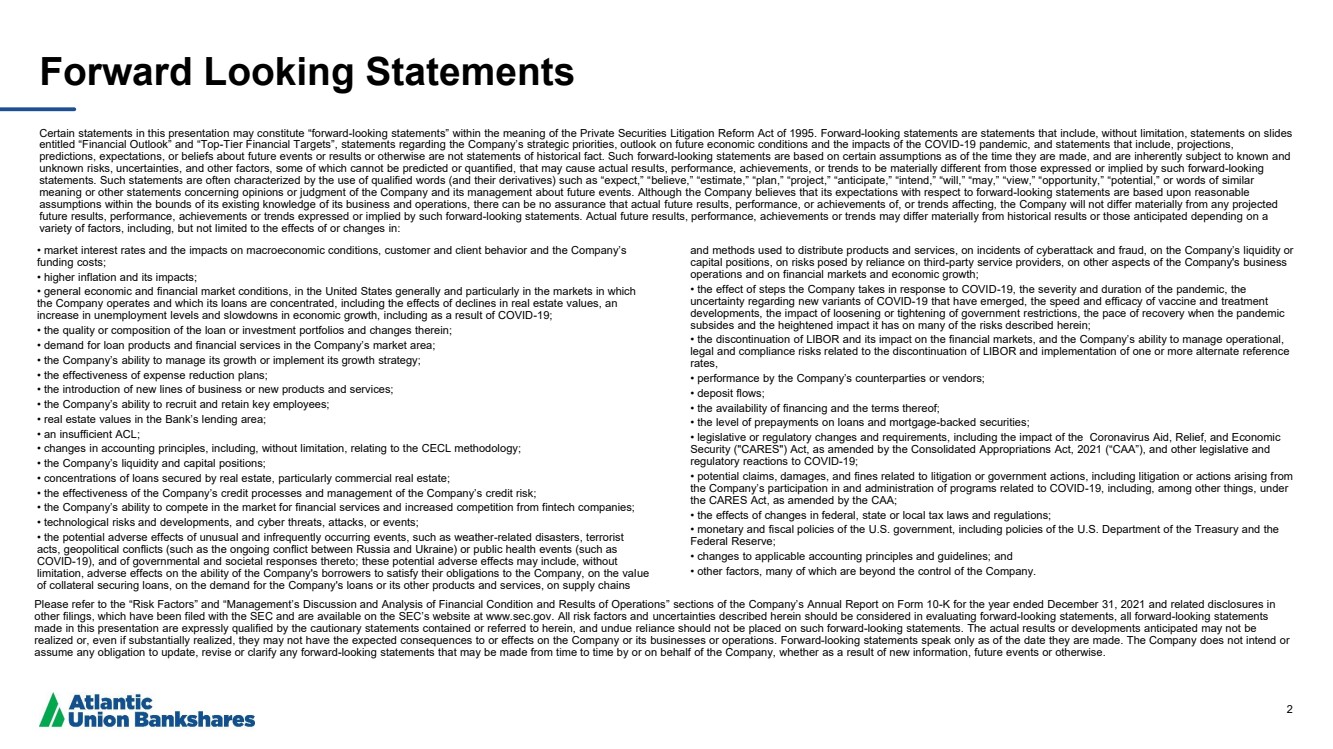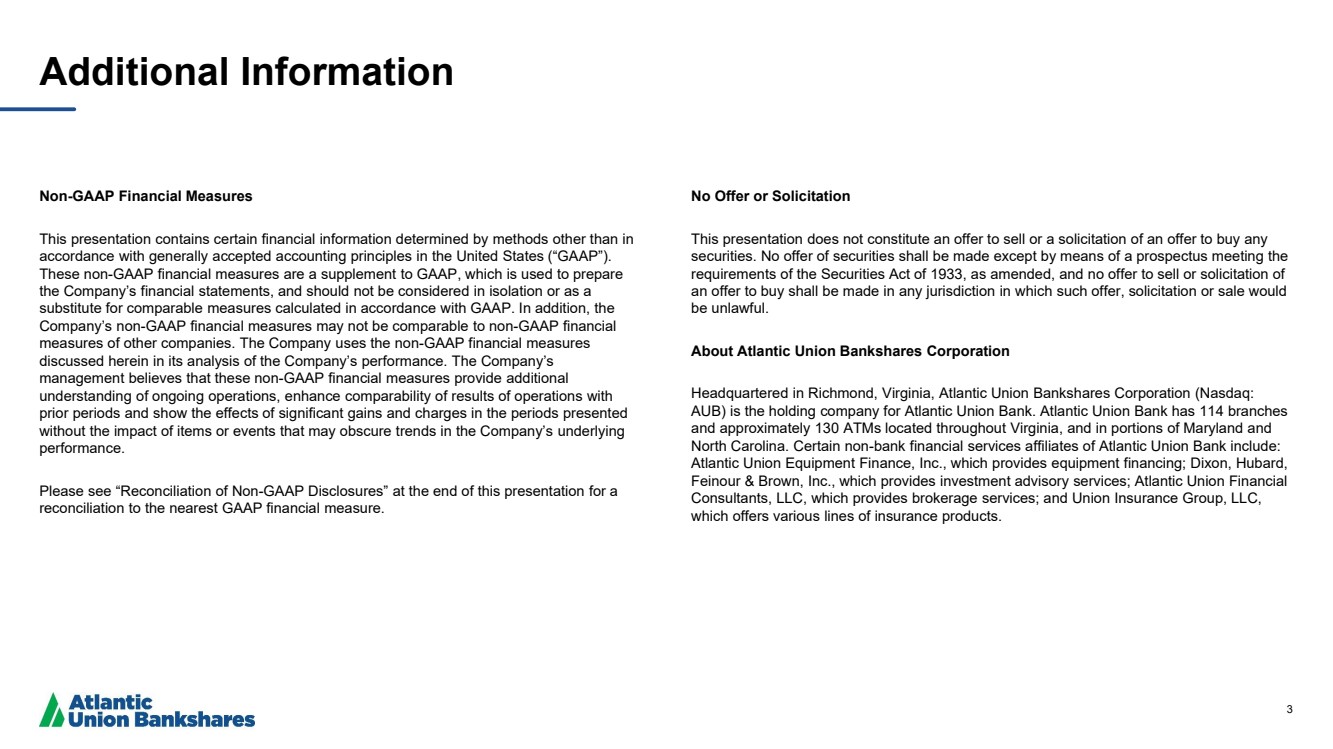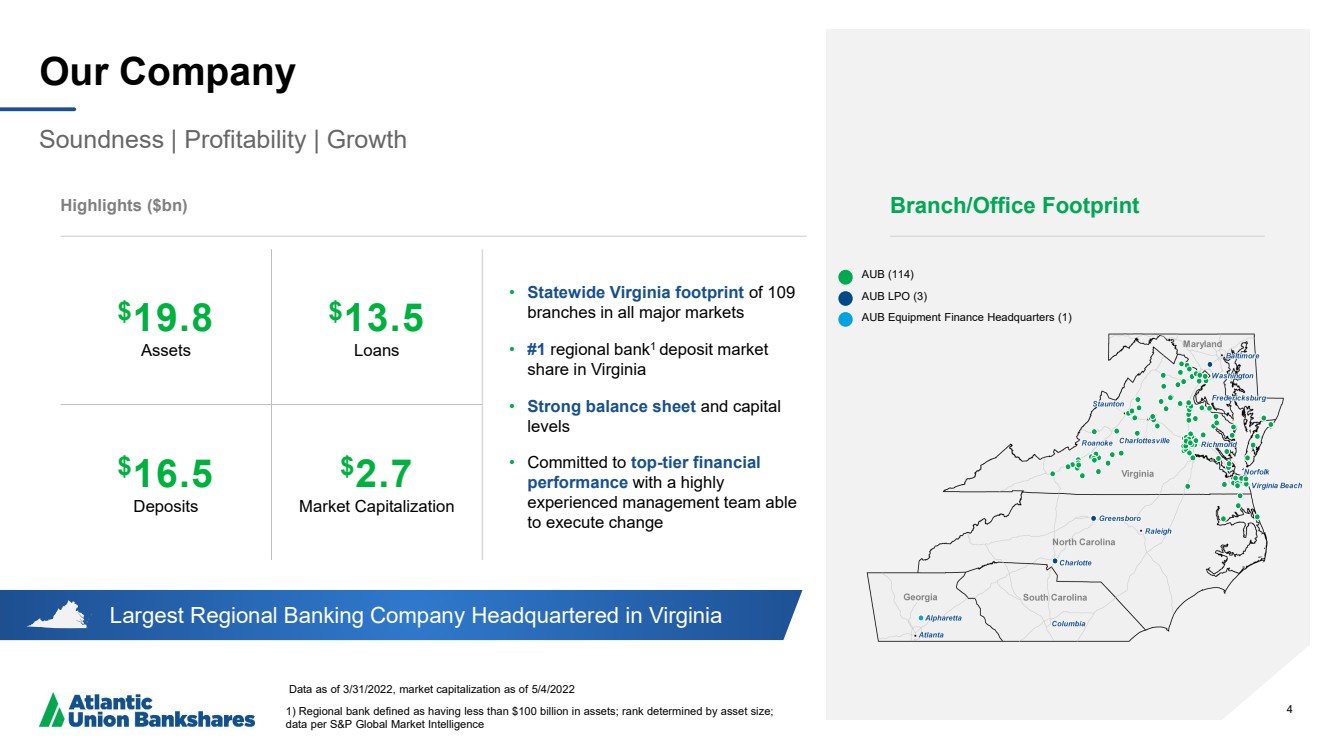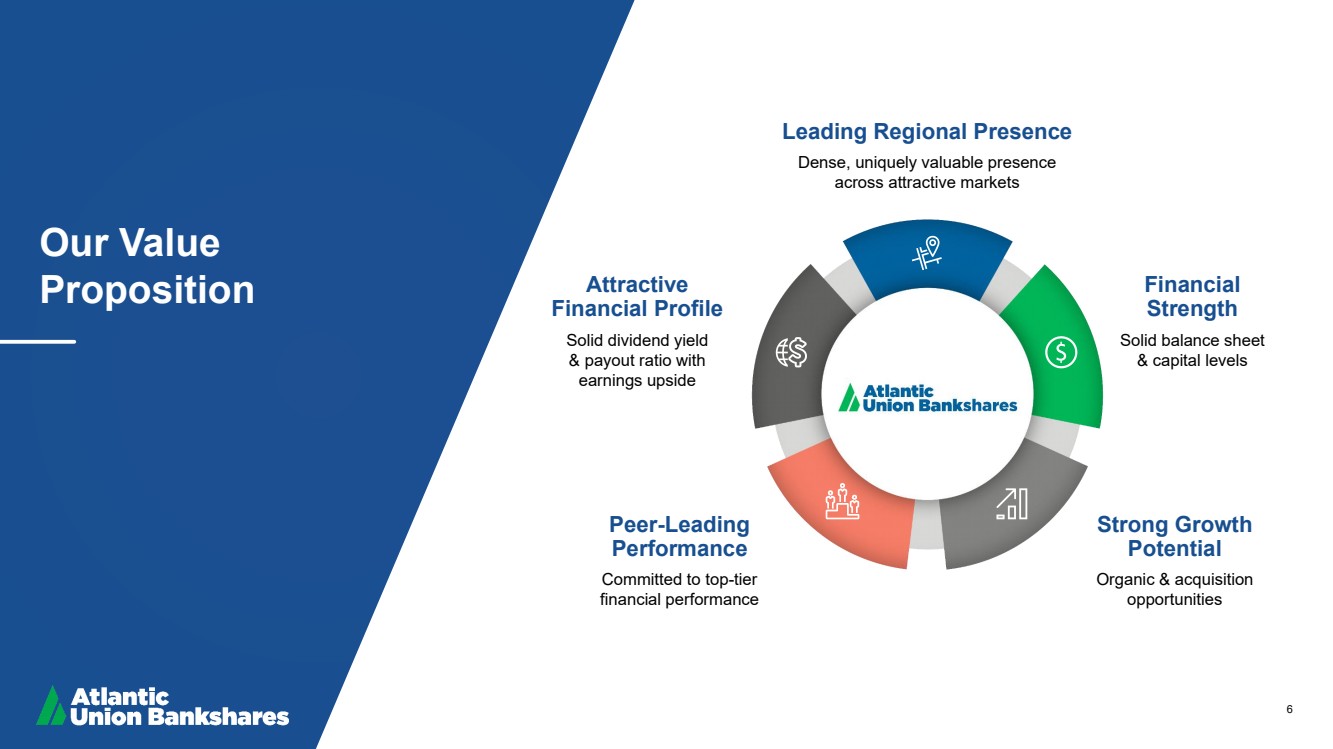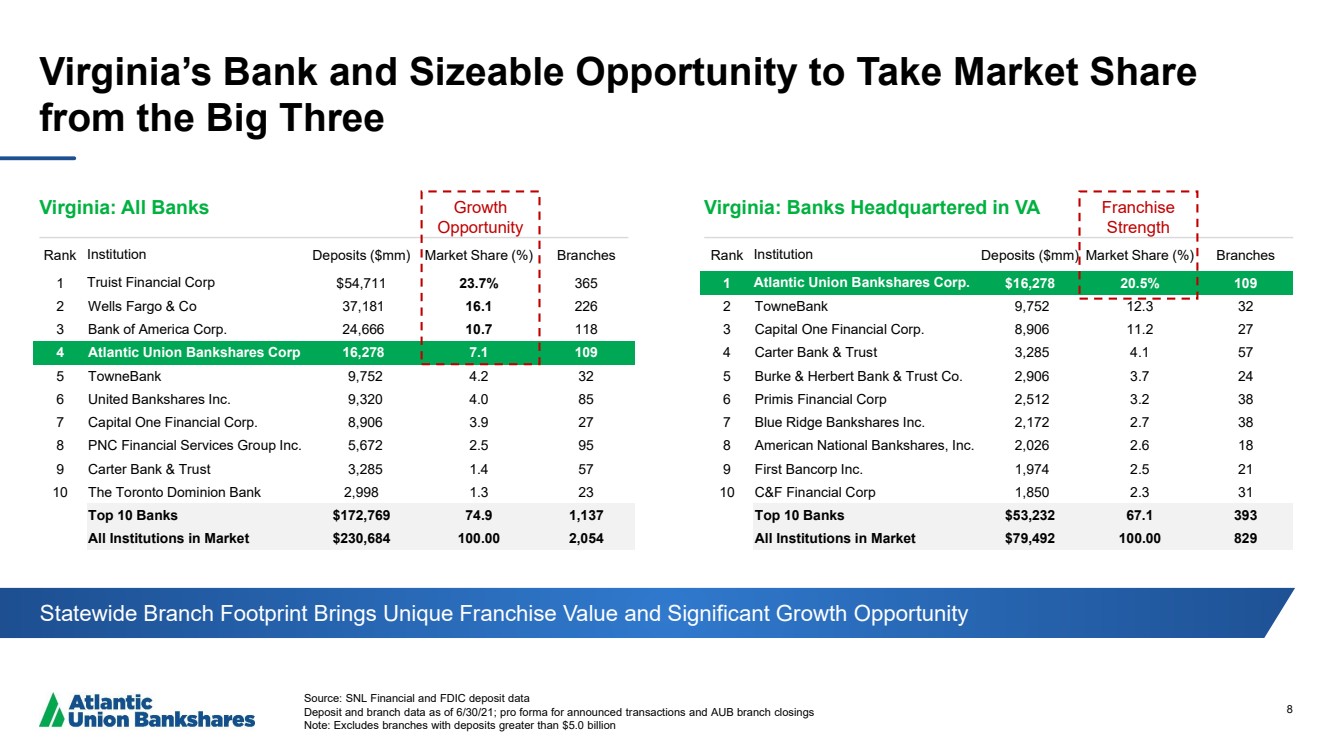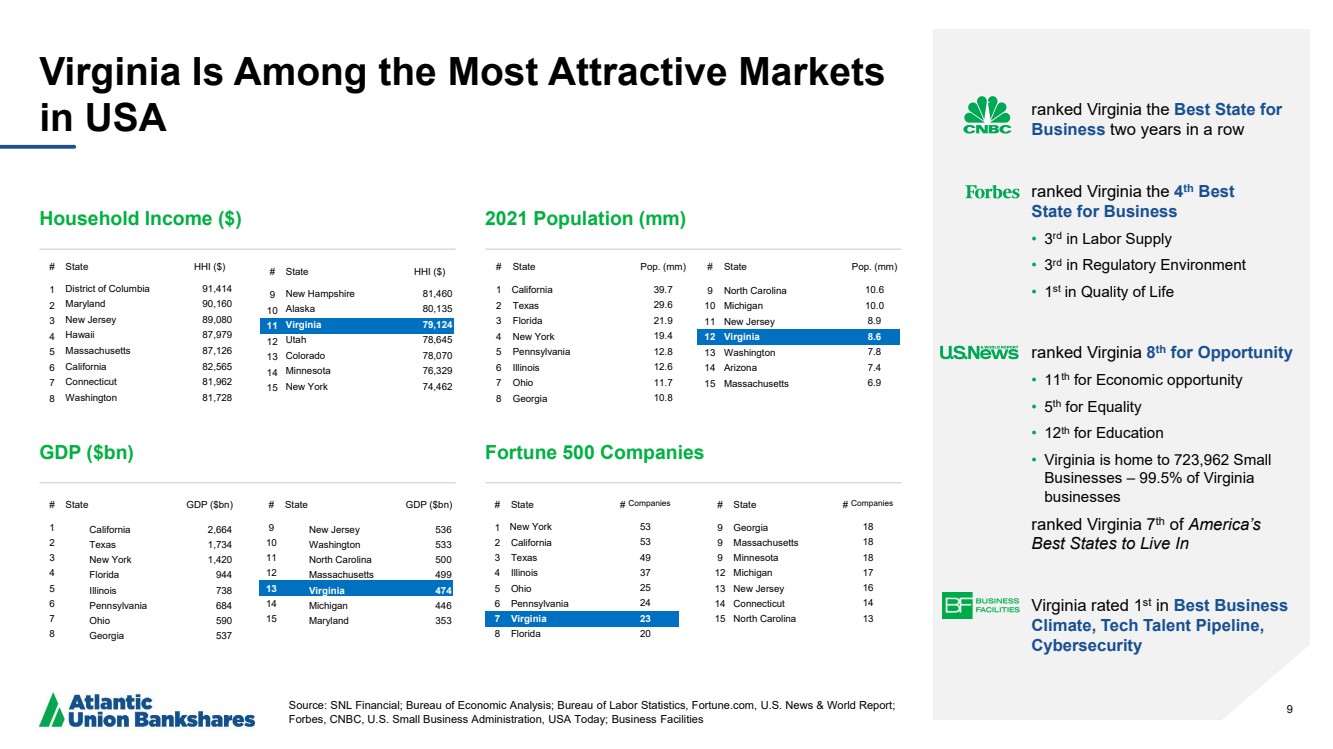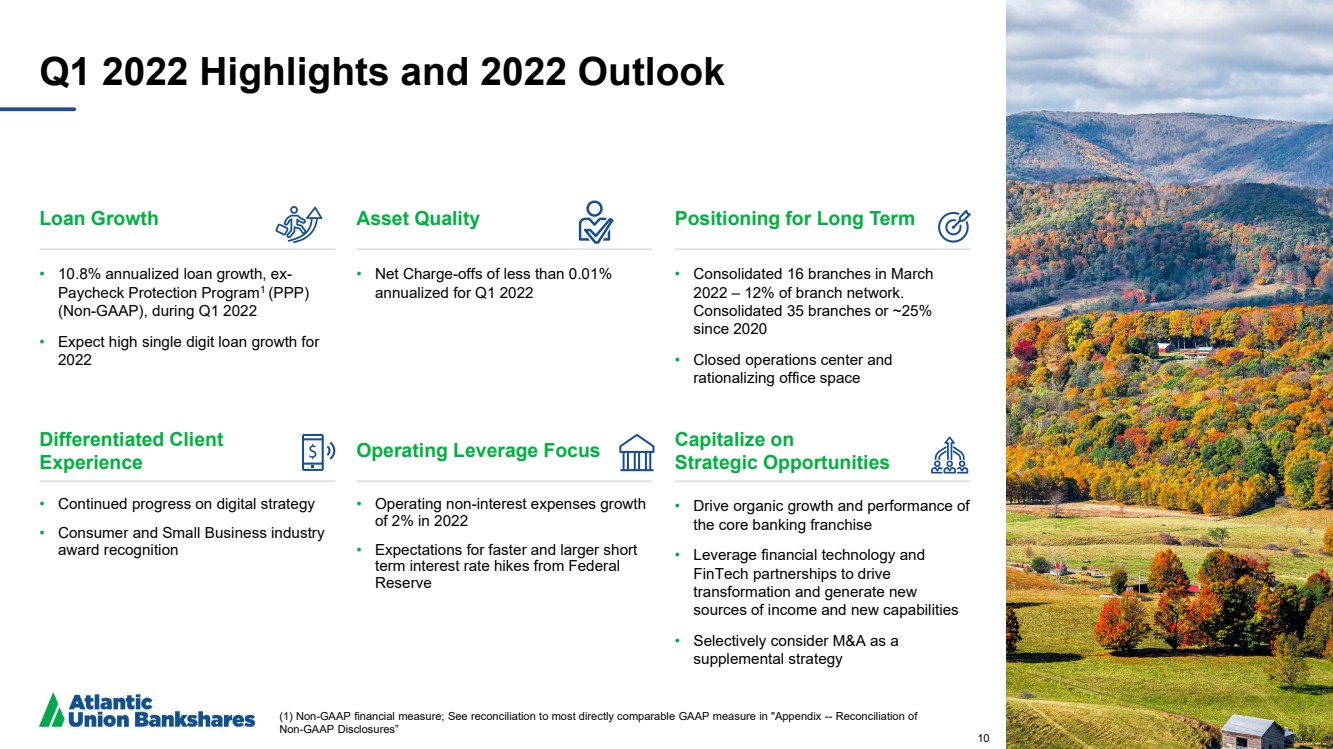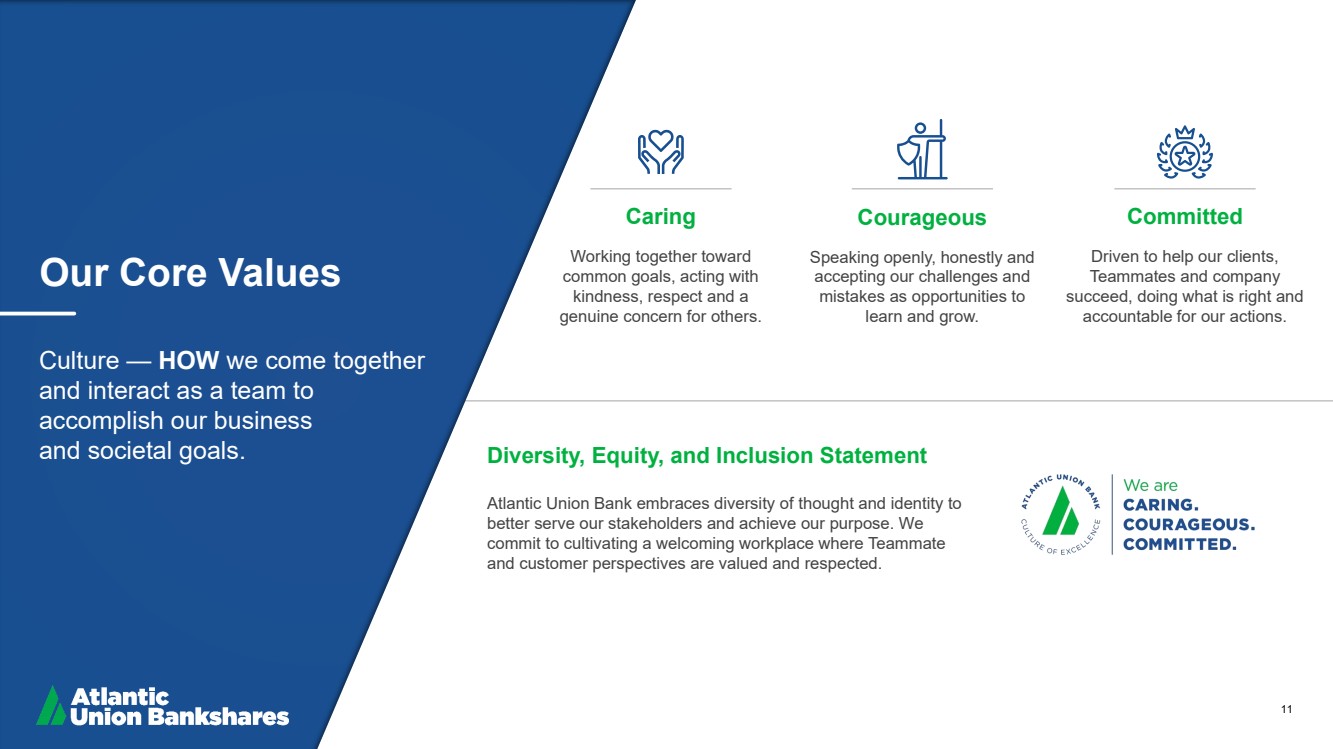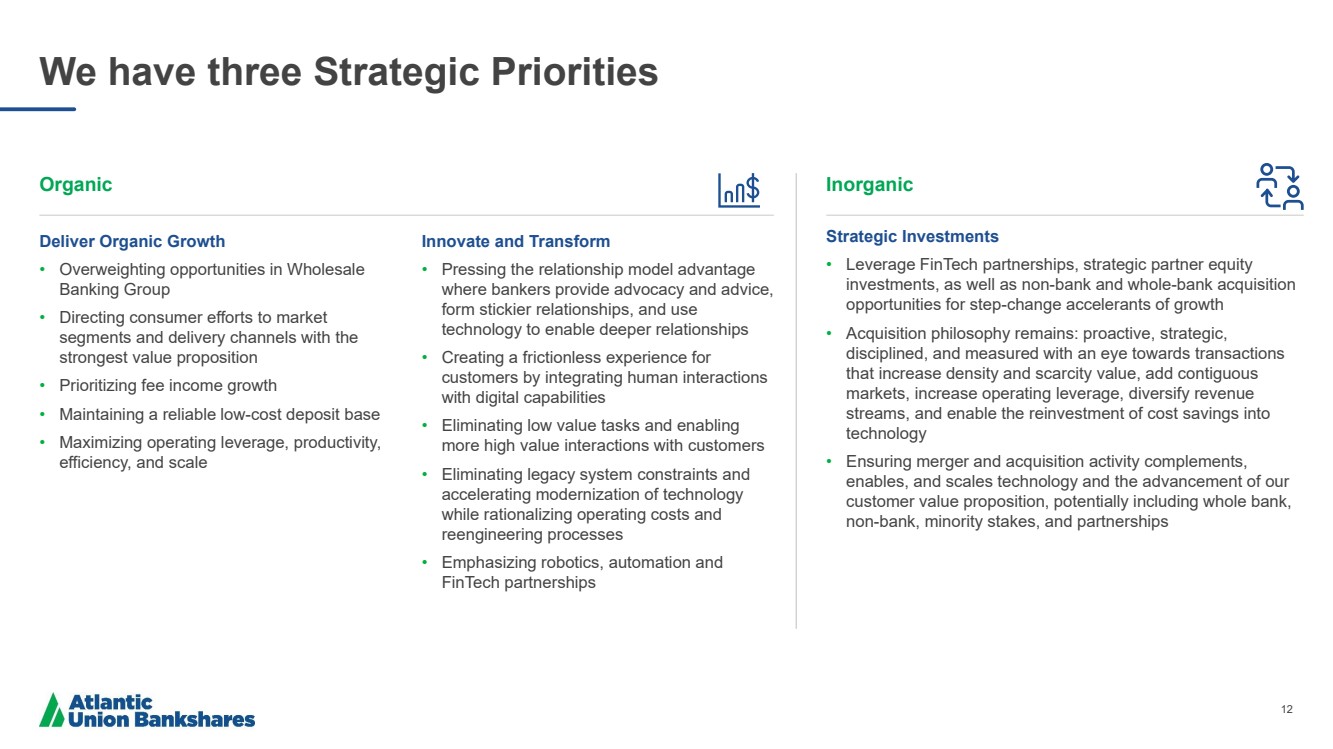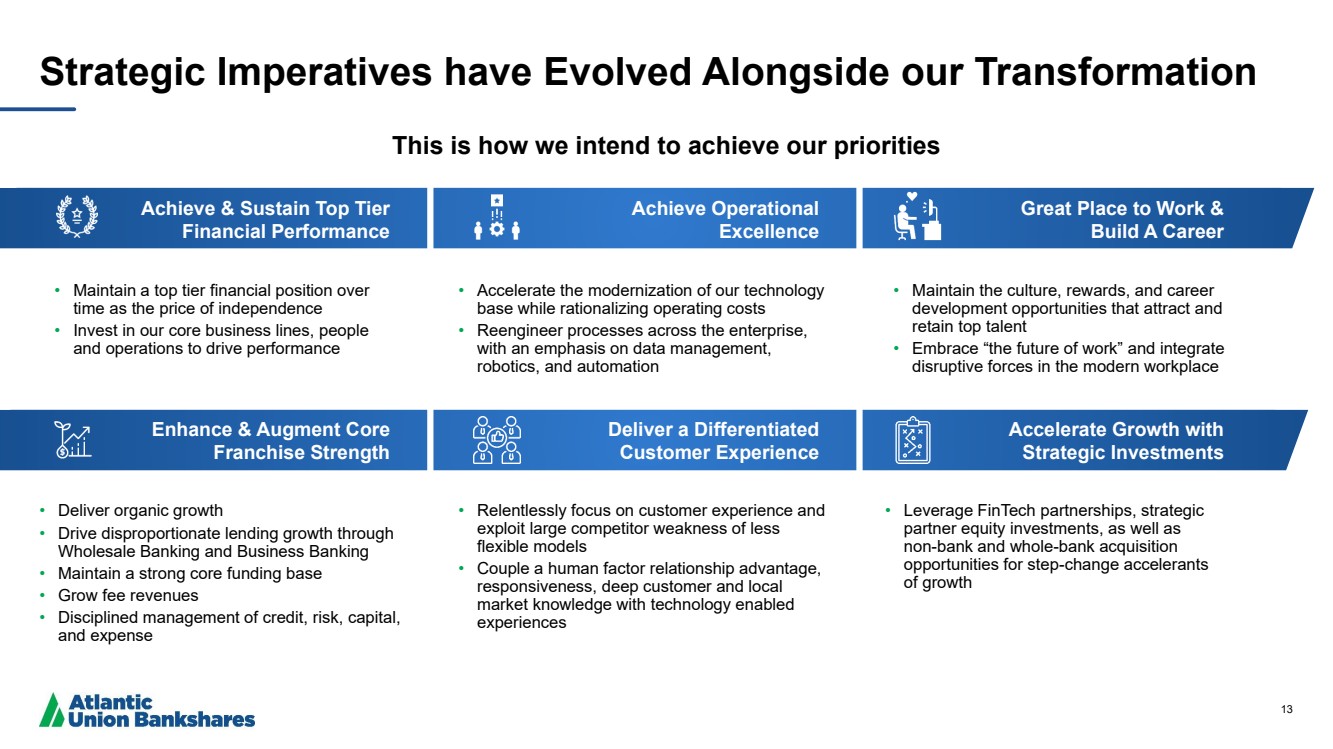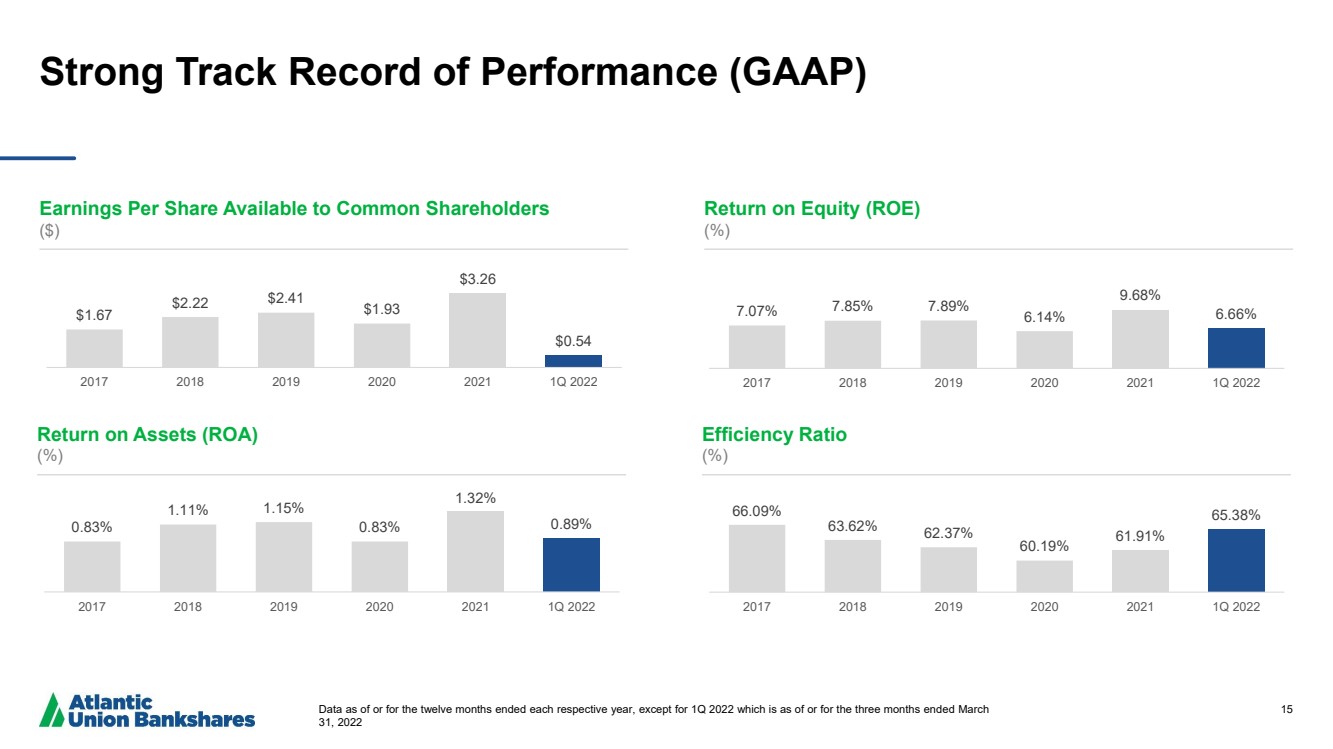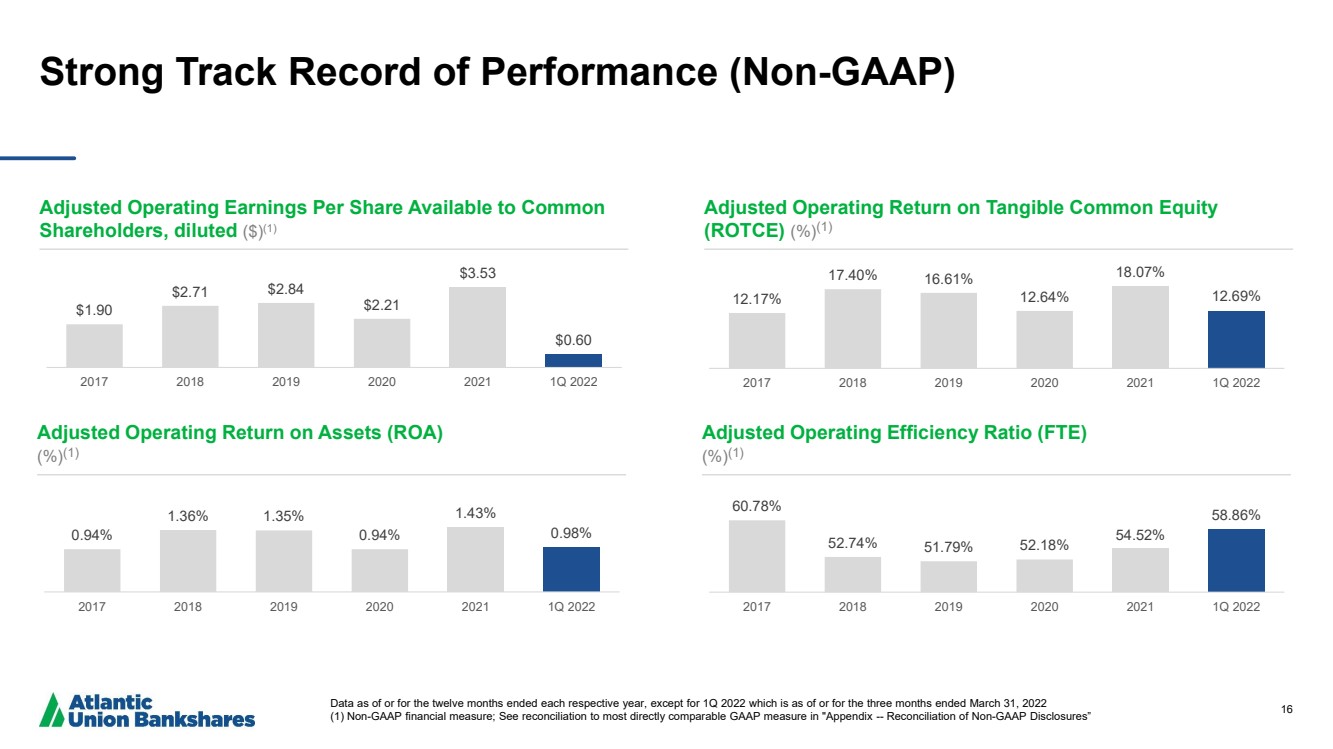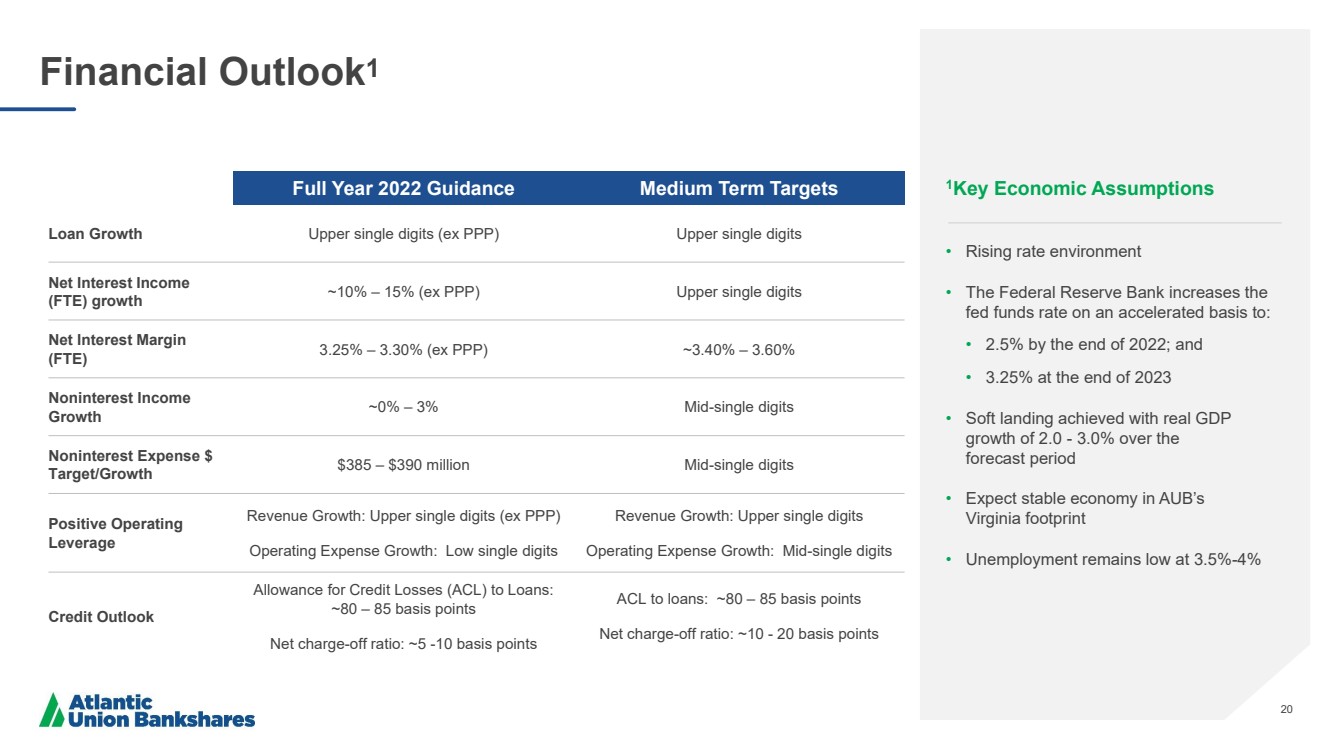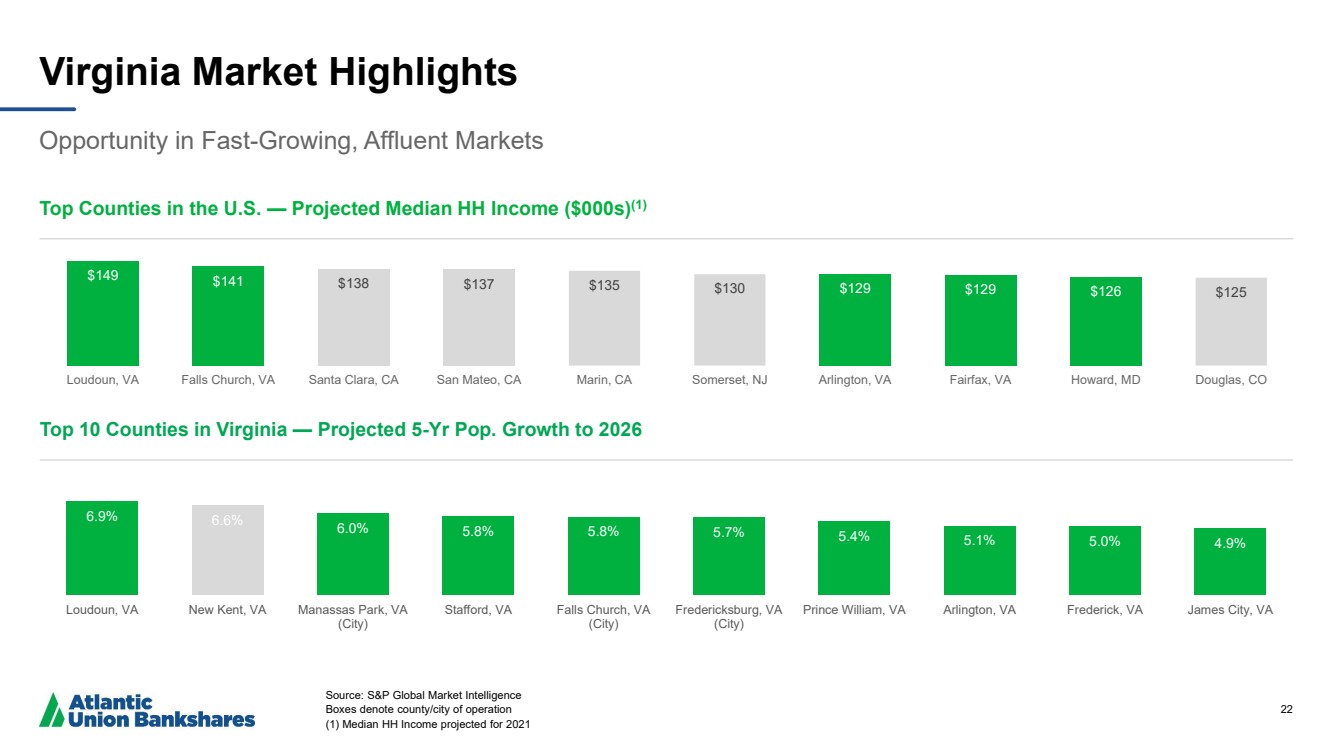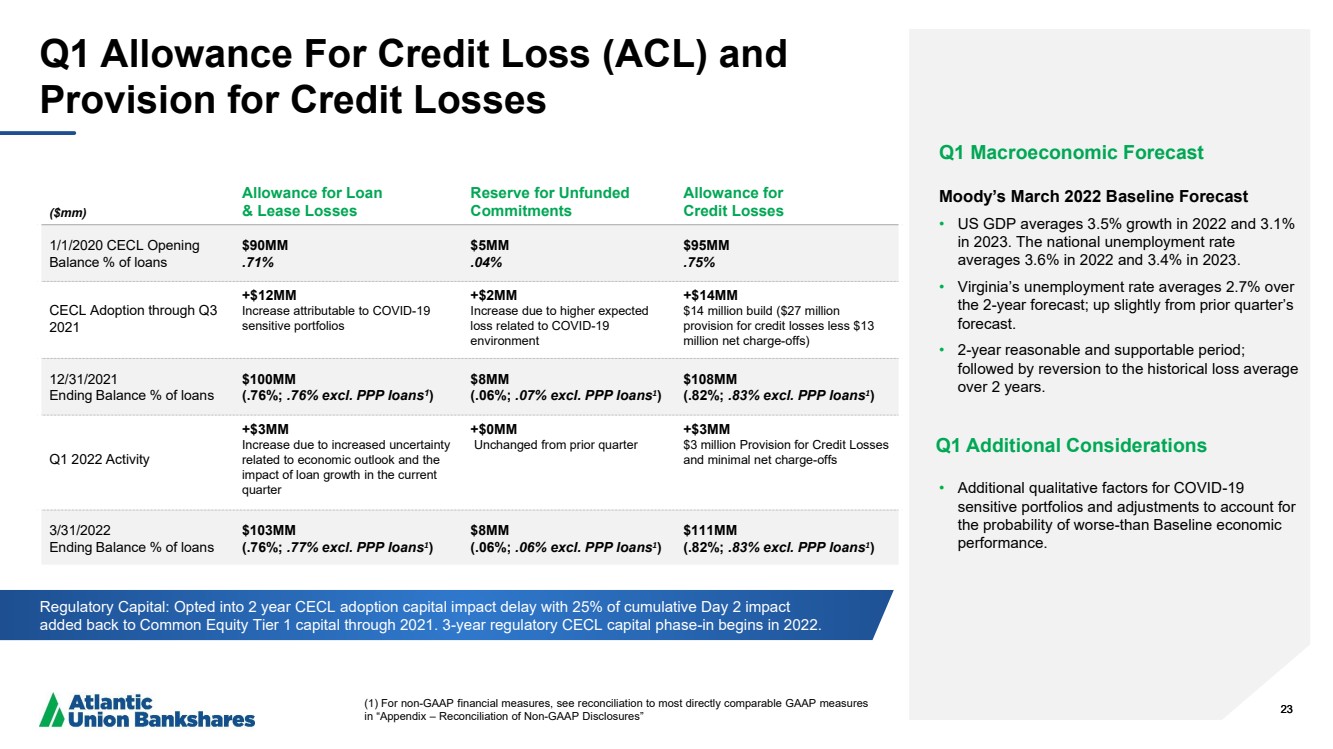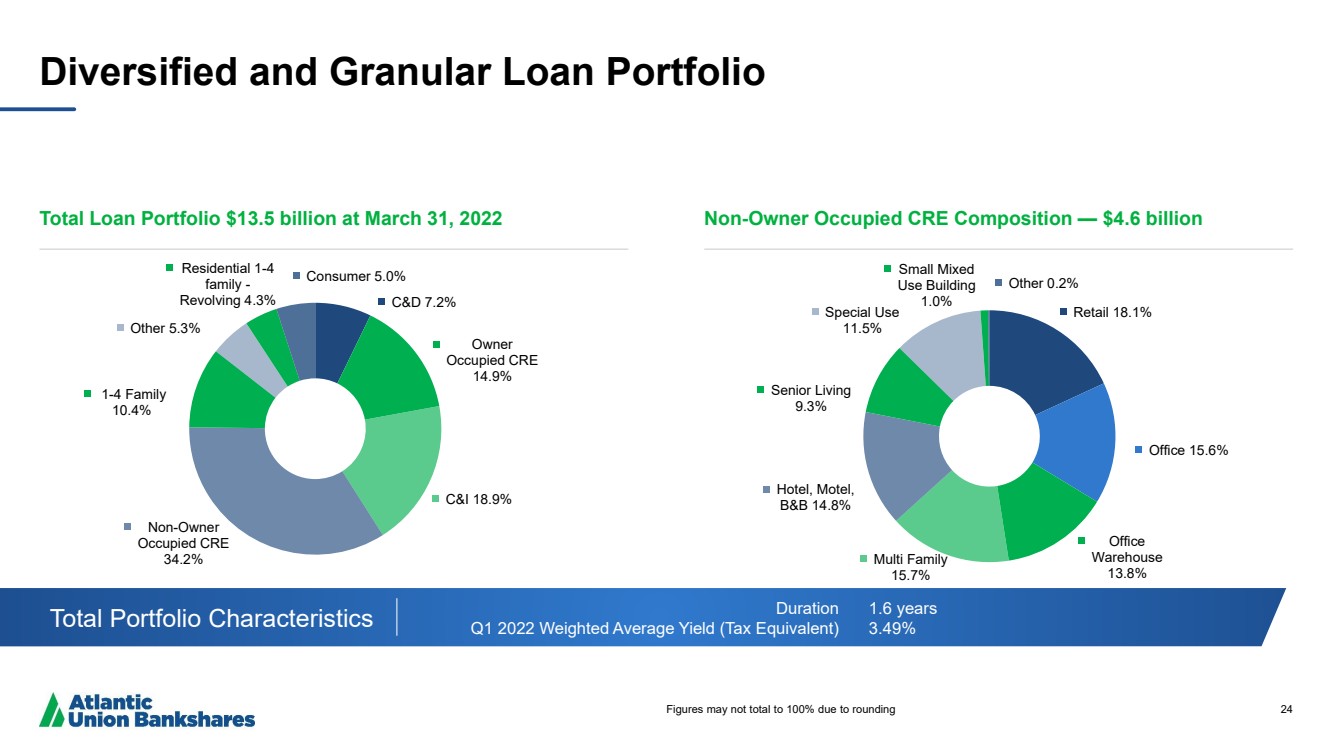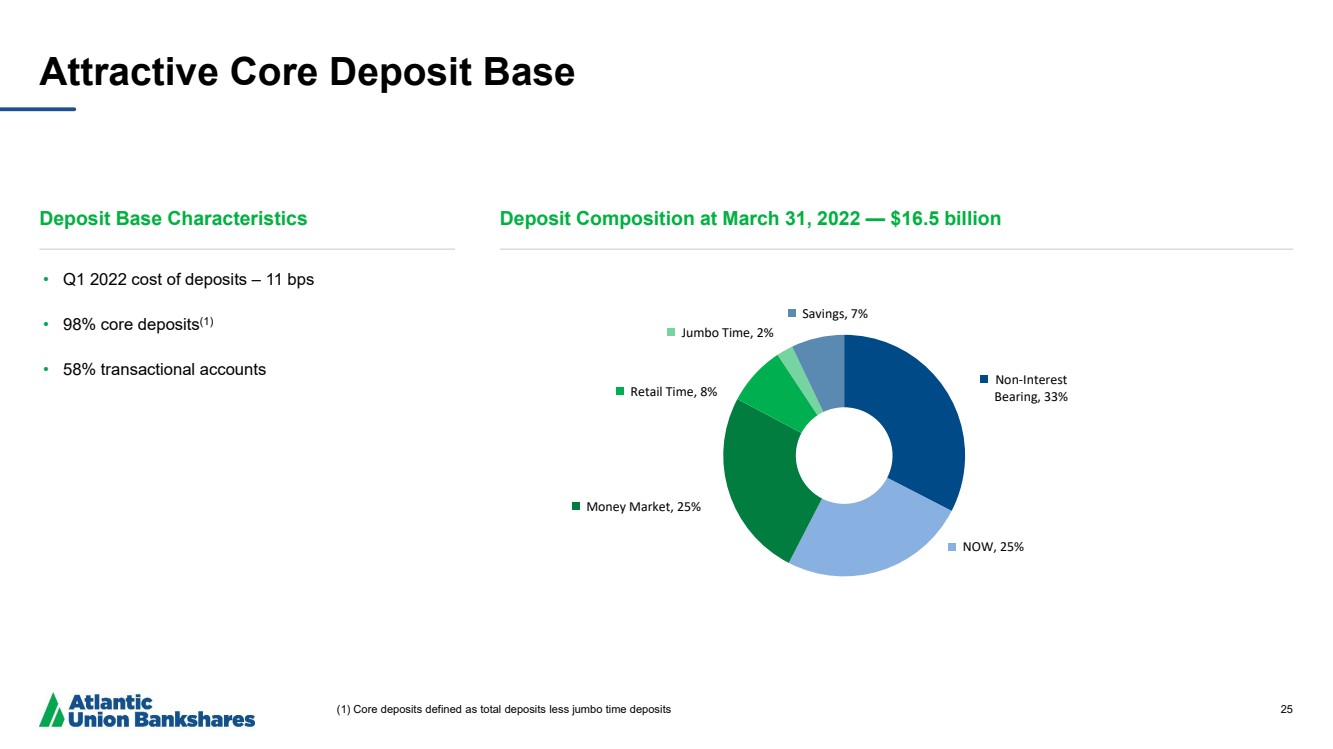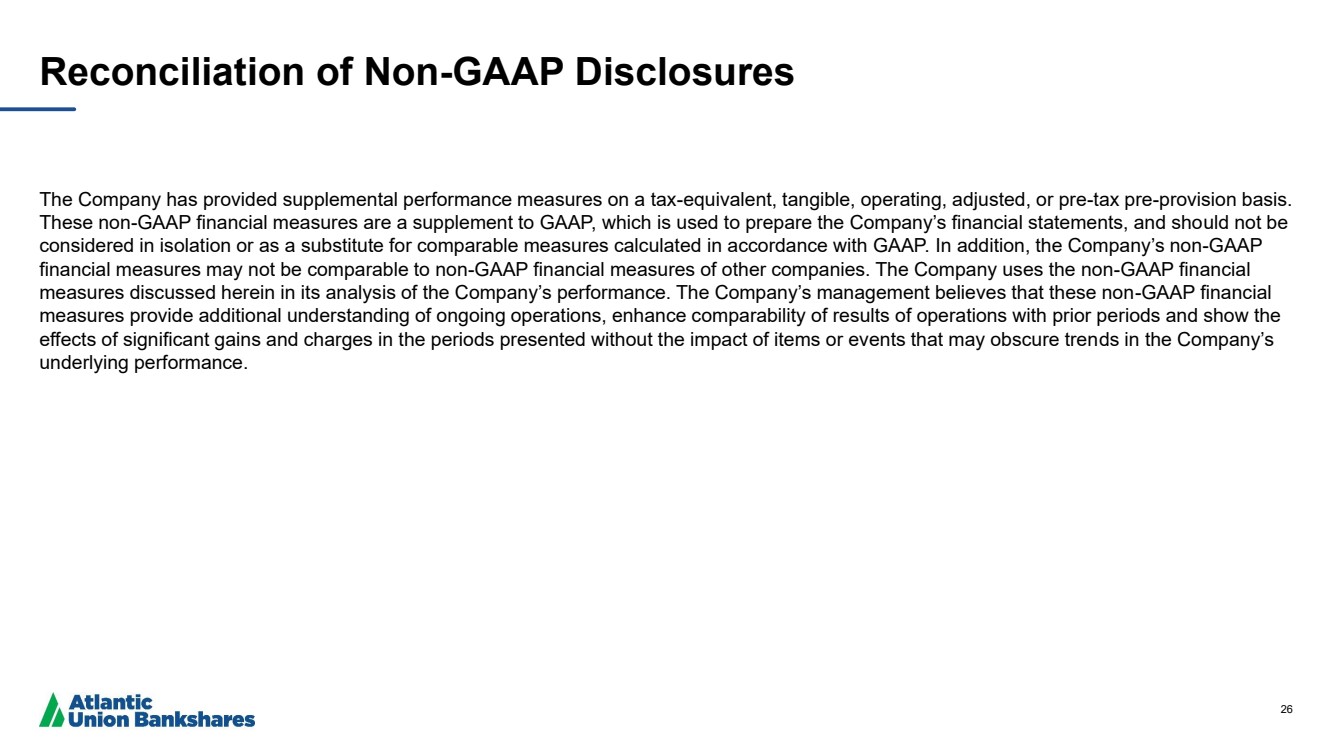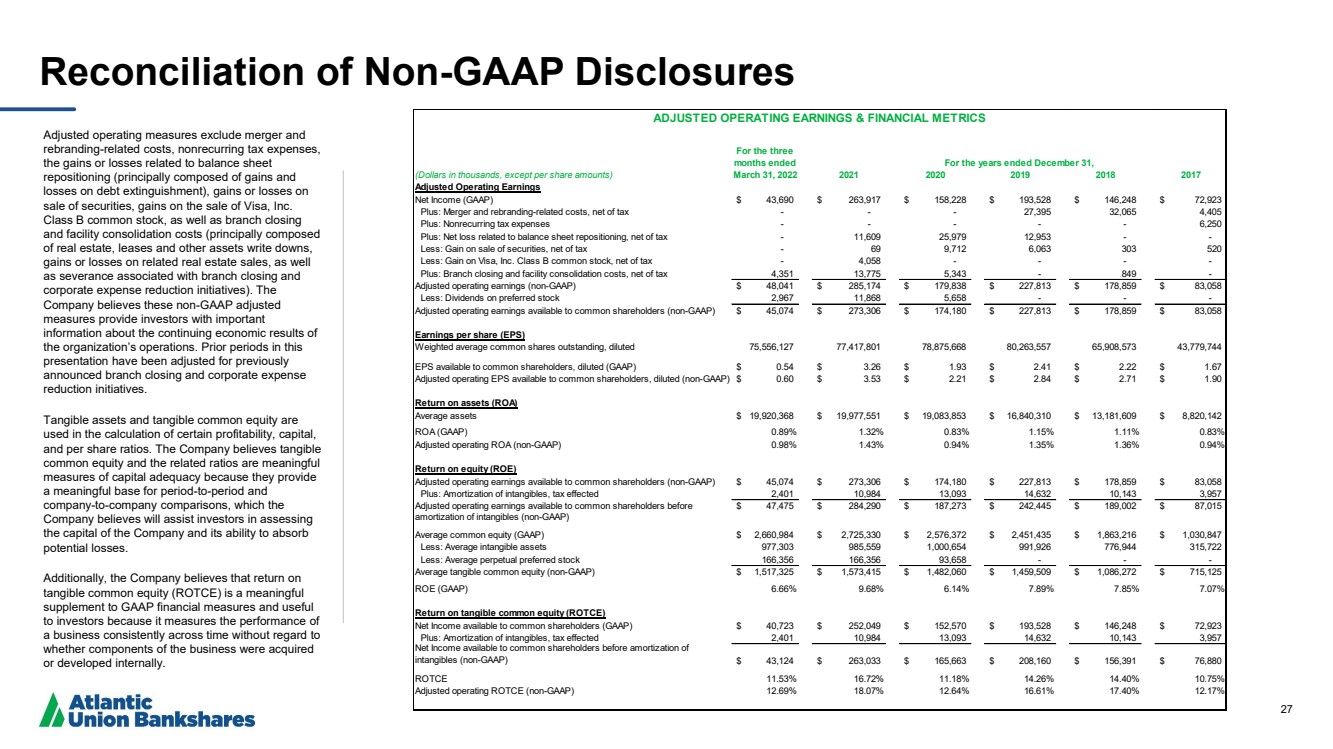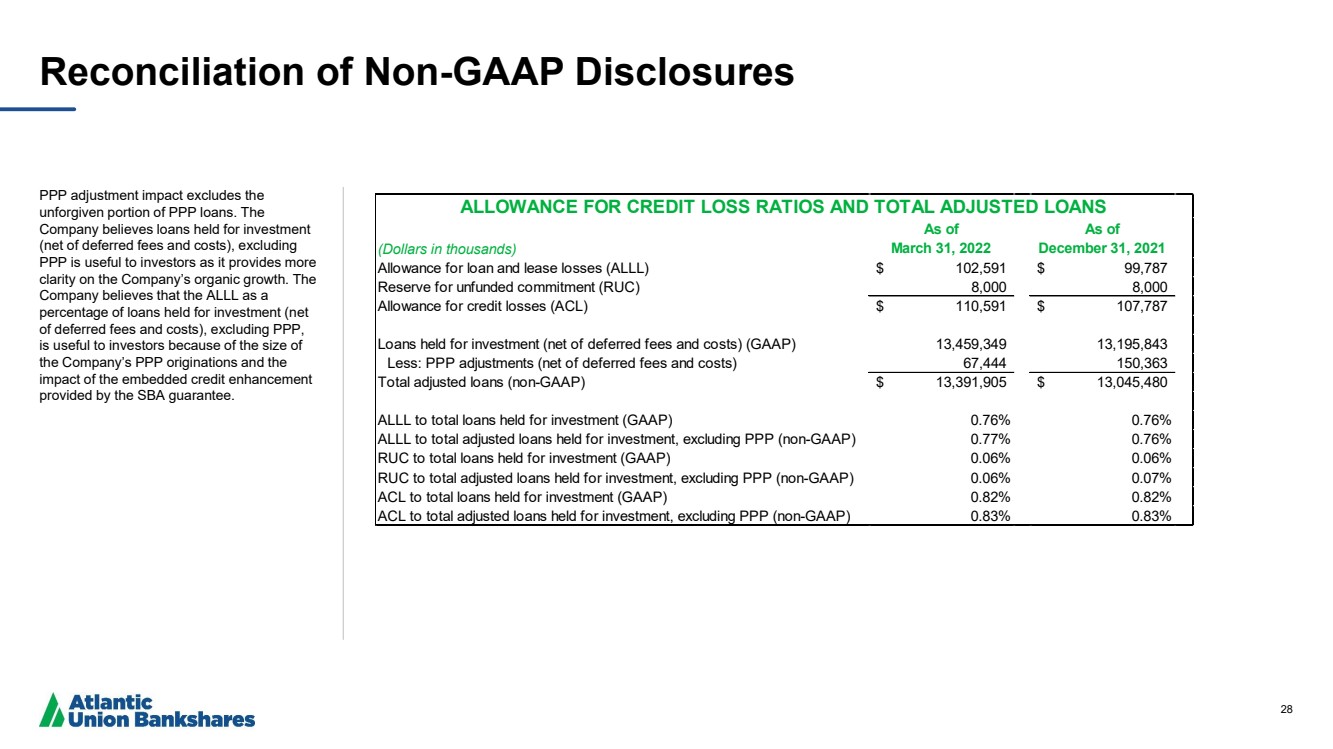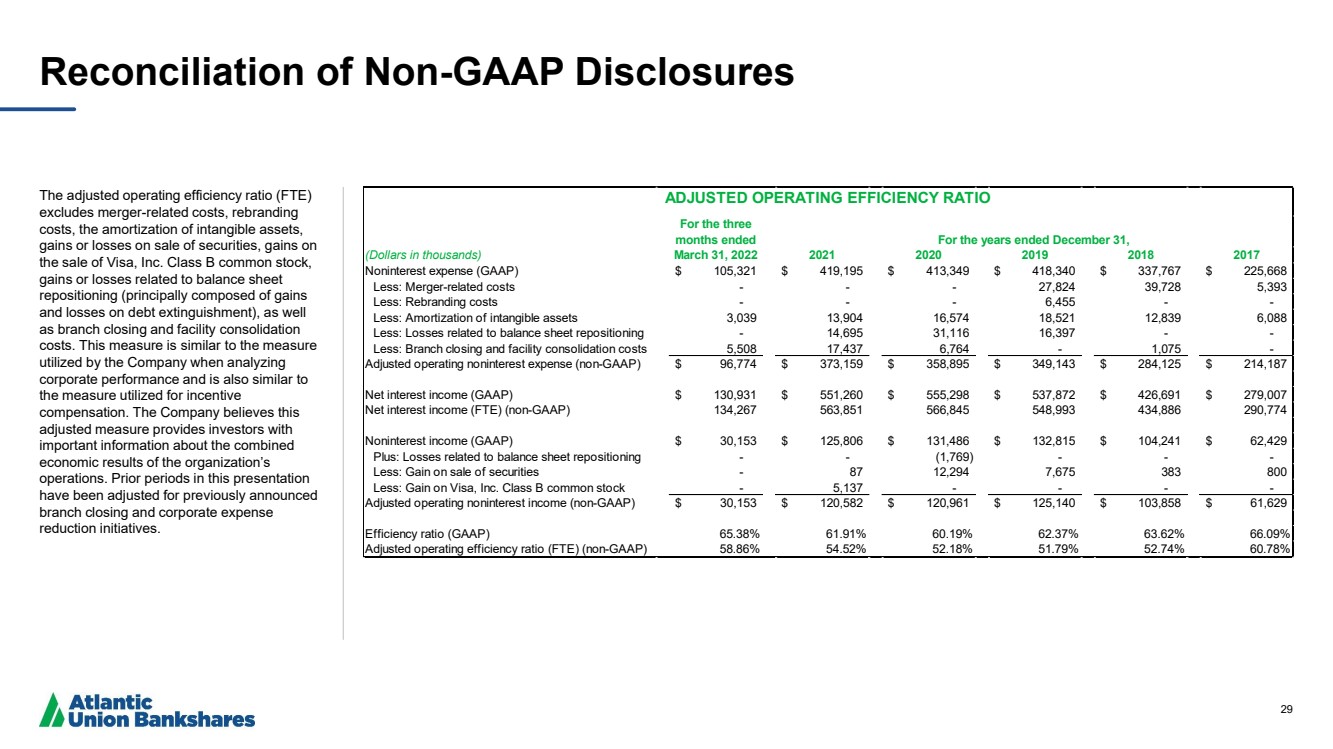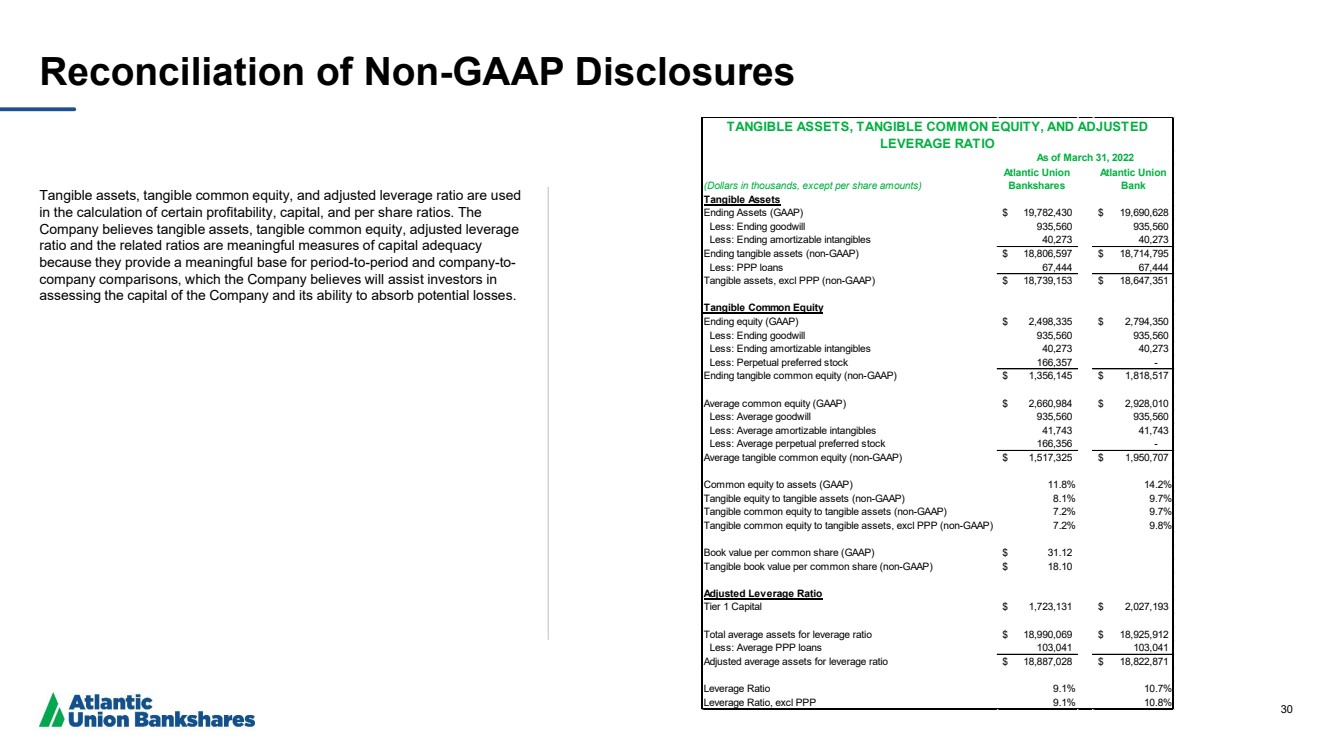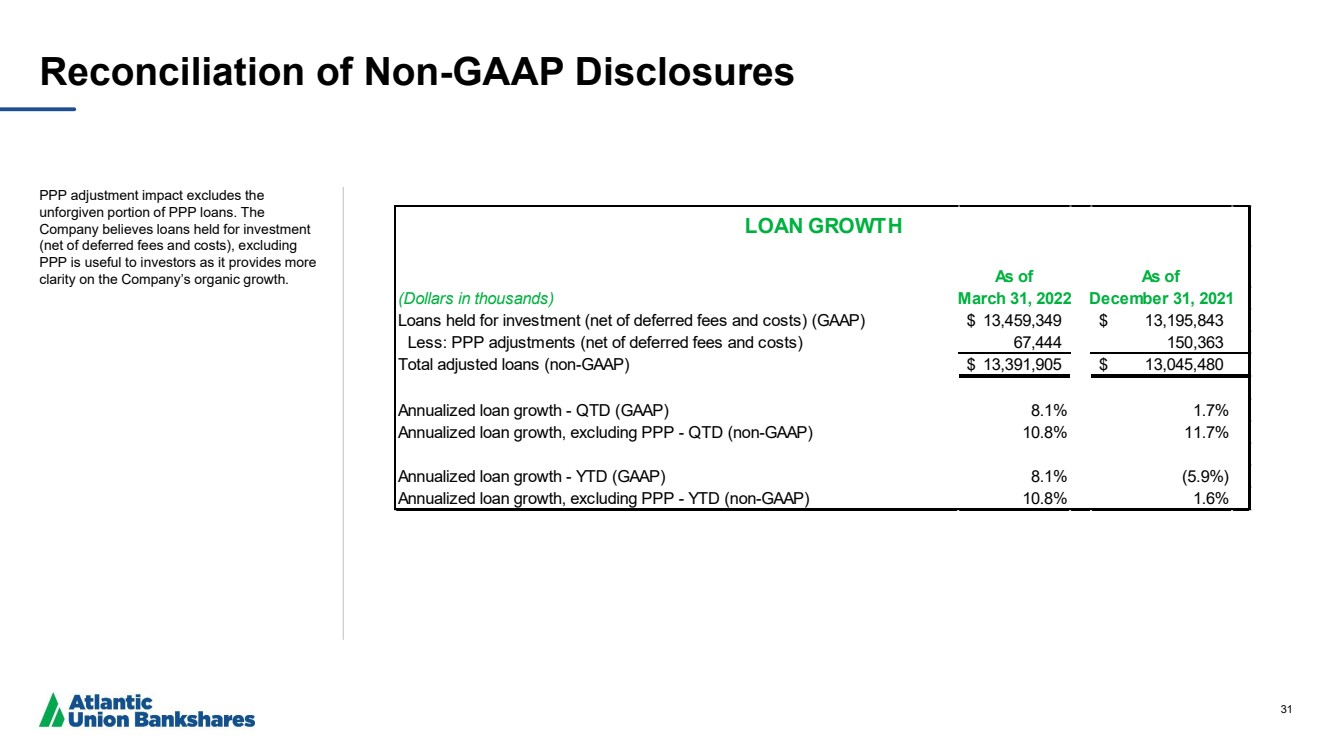| Investor Presentation Nasdaq: AUB May – June 2022 |
| 2 Forward Looking Statements Certain statements in this presentation may constitute “forward - looking statements” within the meaning of the Private Securities Litigation Reform Act of 1995. Forward - looking statements are statements that include, without limitation, statements on slides entitled “Financial Outlook” and “Top - Tier Financial Targets”, statements regarding the Company’s strategic priorities, outlook on future economic conditions and the impacts of the COVID - 19 pandemic, and statements that include, projections, predictions, expectations, or beliefs about future events or results or otherwise are not statements of historical fact. Such fo rward - looking statements are based on certain assumptions as of the time they are made, and are inherently subject to known and unknown risks, uncertainties, and other factors, some of which cannot be predicted or quantified, that may cause actual resul ts, performance, achievements, or trends to be materially different from those expressed or implied by such forward - looking statements. Such statements are often characterized by the use of qualified words (and their derivatives) such as “expect,” “ bel ieve,” “estimate,” “plan,” “project,” “anticipate,” “intend,” “will,” “may,” “view,” “opportunity,” “potential,” or words of sim ilar meaning or other statements concerning opinions or judgment of the Company and its management about future events. Although t he Company believes that its expectations with respect to forward - looking statements are based upon reasonable assumptions within the bounds of its existing knowledge of its business and operations, there can be no assurance that actual fu ture results, performance, or achievements of, or trends affecting, the Company will not differ materially from any projected future results, performance, achievements or trends expressed or implied by such forward - looking statements. Actual future resul ts, performance, achievements or trends may differ materially from historical results or those anticipated depending on a variety of factors, including, but not limited to the effects of or changes in: • market interest rates and the impacts on macroeconomic conditions, customer and client behavior and the Company’s funding costs; • higher inflation and its impacts; • general economic and financial market conditions, in the United States generally and particularly in the markets in which the Company operates and which its loans are concentrated, including the effects of declines in real estate values, an increase in unemployment levels and slowdowns in economic growth, including as a result of COVID - 19; • the quality or composition of the loan or investment portfolios and changes therein; • demand for loan products and financial services in the Company’s market area; • the Company’s ability to manage its growth or implement its growth strategy; • the effectiveness of expense reduction plans; • the introduction of new lines of business or new products and services; • the Company’s ability to recruit and retain key employees; • real estate values in the Bank’s lending area; • an insufficient ACL; • changes in accounting principles, including, without limitation, relating to the CECL methodology; • the Company’s liquidity and capital positions; • concentrations of loans secured by real estate, particularly commercial real estate; • the effectiveness of the Company’s credit processes and management of the Company’s credit risk; • the Company’s ability to compete in the market for financial services and increased competition from fintech companies; • technological risks and developments, and cyber threats, attacks, or events; • the potential adverse effects of unusual and infrequently occurring events, such as weather - related disasters, terrorist acts, geopolitical conflicts (such as the ongoing conflict between Russia and Ukraine) or public health events (such as COVID - 19), and of governmental and societal responses thereto; these potential adverse effects may include, without limitation, adverse effects on the ability of the Company's borrowers to satisfy their obligations to the Company, on the val ue of collateral securing loans, on the demand for the Company's loans or its other products and services, on supply chains and methods used to distribute products and services, on incidents of cyberattack and fraud, on the Company’s liquidity or capital positions, on risks posed by reliance on third - party service providers, on other aspects of the Company's business operations and on financial markets and economic growth; • the effect of steps the Company takes in response to COVID - 19, the severity and duration of the pandemic, the uncertainty regarding new variants of COVID - 19 that have emerged, the speed and efficacy of vaccine and treatment developments, the impact of loosening or tightening of government restrictions, the pace of recovery when the pandemic subsides and the heightened impact it has on many of the risks described herein; • the discontinuation of LIBOR and its impact on the financial markets, and the Company’s ability to manage operational, legal and compliance risks related to the discontinuation of LIBOR and implementation of one or more alternate reference rates, • performance by the Company’s counterparties or vendors; • deposit flows; • the availability of financing and the terms thereof; • the level of prepayments on loans and mortgage - backed securities; • legislative or regulatory changes and requirements, including the impact of the Coronavirus Aid, Relief, and Economic Security ("CARES") Act, as amended by the Consolidated Appropriations Act, 2021 (“CAA”), and other legislative and regulatory reactions to COVID - 19; • potential claims, damages, and fines related to litigation or government actions, including litigation or actions arising f rom the Company’s participation in and administration of programs related to COVID - 19, including, among other things, under the CARES Act, as amended by the CAA; • the effects of changes in federal, state or local tax laws and regulations; • monetary and fiscal policies of the U.S. government, including policies of the U.S. Department of the Treasury and the Federal Reserve; • changes to applicable accounting principles and guidelines; and • other factors, many of which are beyond the control of the Company. Please refer to the “Risk Factors” and “Management’s Discussion and Analysis of Financial Condition and Results of Operations ” s ections of the Company’s Annual Report on Form 10 - K for the year ended December 31, 2021 and related disclosures in other filings, which have been filed with the SEC and are available on the SEC’s website at www.sec.gov. All risk factors and un certainties described herein should be considered in evaluating forward - looking statements, all forward - looking statements made in this presentation are expressly qualified by the cautionary statements contained or referred to herein, and undue rel ian ce should not be placed on such forward - looking statements. The actual results or developments anticipated may not be realized or, even if substantially realized, they may not have the expected consequences to or effects on the Company or its bus inesses or operations. Forward - looking statements speak only as of the date they are made. The Company does not intend or assume any obligation to update, revise or clarify any forward - looking statements that may be made from time to time by or on be half of the Company, whether as a result of new information, future events or otherwise. |
| 3 Additional Information Non - GAAP Financial Measures This presentation contains certain financial information determined by methods other than in accordance with generally accepted accounting principles in the United States (“GAAP”). These non - GAAP financial measures are a supplement to GAAP, which is used to prepare the Company’s financial statements, and should not be considered in isolation or as a substitute for comparable measures calculated in accordance with GAAP. In addition, the Company’s non - GAAP financial measures may not be comparable to non - GAAP financial measures of other companies. The Company uses the non - GAAP financial measures discussed herein in its analysis of the Company’s performance. The Company’s management believes that these non - GAAP financial measures provide additional understanding of ongoing operations, enhance comparability of results of operations with prior periods and show the effects of significant gains and charges in the periods presented without the impact of items or events that may obscure trends in the Company’s underlying performance. Please see “Reconciliation of Non - GAAP Disclosures” at the end of this presentation for a reconciliation to the nearest GAAP financial measure. No Offer or Solicitation This presentation does not constitute an offer to sell or a solicitation of an offer to buy any securities. No offer of securities shall be made except by means of a prospectus meeting the requirements of the Securities Act of 1933, as amended, and no offer to sell or solicitation of an offer to buy shall be made in any jurisdiction in which such offer, solicitation or sale would be unlawful. About Atlantic Union Bankshares Corporation Headquartered in Richmond, Virginia, Atlantic Union Bankshares Corporation (Nasdaq: AUB) is the holding company for Atlantic Union Bank. Atlantic Union Bank has 114 branches and approximately 130 ATMs located throughout Virginia, and in portions of Maryland and North Carolina. Certain non - bank financial services affiliates of Atlantic Union Bank include: Atlantic Union Equipment Finance, Inc., which provides equipment financing; Dixon, Hubard, Feinour & Brown, Inc., which provides investment advisory services; Atlantic Union Financial Consultants, LLC, which provides brokerage services; and Union Insurance Group, LLC, which offers various lines of insurance products. |
| 4 Largest Regional Banking Company Headquartered in Virginia Our Company Soundness | Profitability | Growth Data as of 3/31/2022, market capitalization as of 5/4/2022 1) Regional bank defined as having less than $100 billion in assets; rank determined by asset size; data per S&P Global Market Intelligence Highlights ($bn) • Statewide Virginia footprint of 109 branches in all major markets • #1 regional bank 1 deposit market share in Virginia • Strong balance sheet and capital levels • Committed to top - tier financial performance with a highly experienced management team able to execute change 4 $ 19 ..8 Assets $ 13.5 Loans $ 16.5 Deposits $ 2 ..7 Market Capitalization Branch/Office Footprint AUB (114) AUB LPO (3) AUB Equipment Finance Headquarters (1) |
| 5 A Transformation Story From Virginia Community Bank to Virginia’s Bank and More Virginia’s Bank The Atlantic Union “Moat” – Stronger than Ever • Virginia’s first and only statewide, independent bank in over 20 years • The alternative to large competitors • Organic growth model + effective consolidator • Scarcity value - franchise cannot be replicated • “Crown jewel” deposit base - 58% transaction accounts • Dense, compact and contiguous ~$20B bank Larger Bank Executive Leadership Talent Magnet • Knows the “seams” of the large institutions & how to compete against them • Makes tough decisions – think differently, challenge, escape the past • Does what we say we will do • Extensive hiring from larger institutions at all levels • We know the people we hire and rarely use recruiters • Client facing market leaders and bankers hired from the markets they serve “Soundness, profitability & growth in that order of priority” | Our philosophy for how we run our company |
| 6 Our Value Proposition Leading Regional Presence Dense, uniquely valuable presence across attractive markets Financial Strength Solid balance sheet & capital levels Attractive Financial Profile Solid dividend yield & payout ratio with earnings upside Strong Growth Potential Organic & acquisition opportunities Peer - Leading Performance Committed to top - tier financial performance |
| 7 Strong Presence in Prime Virginia Markets (1) Among midsized and community banks less than $100 billion in assets Source: SNL Financial; excludes branches greater than $5 billion Deposit data as of 6/30/2021; Fredericksburg market defined as Caroline, Fredericksburg City, King George, Spotsylvania and Stafford counties; all other markets per MSA definitions in SNL 7 Coastal Virginia Military, Shipbuilding, Fortune 500 headquarters (3), Tourism • $1.6 billion in - market deposits and total deposit market share of 5.1% Roanoke Blacksburg Virginia Tech, Healthcare, Retail • $1.4 billion in - market deposits and total deposit market share of 9.5% Northern Virginia Nation’s Capital, Fortune 500 headquarters ( 13), Defense and security contractors, Non - profit Associations (lobbyists), HQ2 • $5.7 billion in - market deposits and total deposit market share of 5.5% Diversity Supports Growth In Virginia Richmond State Capital, Fortune 500 headquarters (7), VCU & VCU Medical Center • $4.2 billion in - market deposits and total deposit market share of 11.5% Fredericksburg Defense and security contractors, Healthcare, Retail, Real Estate development • $1.7 billion in - market deposits and total deposit market share of 27.6% Charlottesville University of Virginia, High - tech and professional businesses, Real Estate development • $748 million in - market deposits and total deposit market share of 11.4% #1 Market Share (1) #2 Market Share (1) #2 Market Share (1) #1 Market Share (1) #1 Market Share (1) #1 Market Share (1) |
| 8 Virginia’s Bank and Sizeable Opportunity to Take Market Share from the Big Three Source: SNL Financial and FDIC deposit data Deposit and branch data as of 6/30/21; pro forma for announced transactions and AUB branch closings Note: Excludes branches with deposits greater than $5.0 billion Virginia: All Banks Virginia: Banks Headquartered in VA Rank Institution Deposits ($mm) Market Share (%) Branches 1 Truist Financial Corp $54,711 23.7% 365 2 Wells Fargo & Co 37,181 16.1 226 3 Bank of America Corp. 24,666 10.7 118 4 Atlantic Union Bankshares Corp 16,278 7.1 109 5 TowneBank 9,752 4.2 32 6 United Bankshares Inc. 9,320 4.0 85 7 Capital One Financial Corp. 8,906 3.9 27 8 PNC Financial Services Group Inc. 5,672 2.5 95 9 Carter Bank & Trust 3,285 1.4 57 10 The Toronto Dominion Bank 2,998 1.3 23 Top 10 Banks $ 172,769 74.9 1,137 All Institutions in Market $230,684 100.00 2,054 Rank Institution Deposits ($mm) Market Share (%) Branches 1 Atlantic Union Bankshares Corp. $16,278 20.5% 109 2 TowneBank 9,752 12.3 32 3 Capital One Financial Corp. 8,906 11.2 27 4 Carter Bank & Trust 3,285 4.1 57 5 Burke & Herbert Bank & Trust Co. 2,906 3.7 24 6 Primis Financial Corp 2,512 3.2 38 7 Blue Ridge Bankshares Inc. 2,172 2.7 38 8 American National Bankshares, Inc. 2,026 2.6 18 9 First Bancorp Inc. 1,974 2.5 21 10 C&F Financial Corp 1,850 2.3 31 Top 10 Banks $53,232 67.1 393 All Institutions in Market $79,492 100.00 829 Statewide Branch Footprint Brings Unique Franchise Value and Significant Growth Opportunity Growth Opportunity Franchise Strength |
| 9 Virginia Is Among the Most Attractive Markets in USA Source: SNL Financial; Bureau of Economic Analysis; Bureau of Labor Statistics, Fortune.com, U.S. News & World Report; Forbes, CNBC, U.S. Small Business Administration, USA Today; Business Facilities 9 ranked Virginia the Best State for Business two years in a row ranked Virginia the 4 th Best State for Business • 3 rd in Labor Supply • 3 rd in Regulatory Environment • 1 st in Quality of Life ranked Virginia 8 th for Opportunity • 11 th for Economic opportunity • 5 th for Equality • 12 th for Education • Virginia is home to 723,962 Small Businesses – 99.5% of Virginia businesses ranked Virginia 7 th of America’s Best States to Live In Virginia rated 1 st in Best Business Climate, Tech Talent Pipeline, Cybersecurity # State # Companies 1 New York 53 2 California 53 3 Texas 49 4 Illinois 37 5 Ohio 25 6 Pennsylvania 24 7 Virginia 23 8 Florida 20 # State Pop. (mm) 1 California 39.7 2 Texas 29.6 3 Florida 21.9 4 New York 19.4 5 Pennsylvania 12.8 6 Illinois 12.6 7 Ohio 11.7 8 Georgia 10.8 # State HHI ($) 1 District of Columbia 91,414 2 Maryland 90,160 3 New Jersey 89,080 4 Hawaii 87,979 5 Massachusetts 87,126 6 California 82,565 7 Connecticut 81,962 8 Washington 81,728 # State GDP ($bn) 1 California 2,664 2 Texas 1,734 3 New York 1,420 4 Florida 944 5 Illinois 738 6 Pennsylvania 684 7 Ohio 590 8 Georgia 537 Household Income ($) 2021 Population (mm) # State Pop. (mm) 9 North Carolina 10.6 10 Michigan 10.0 11 New Jersey 8.9 12 Virginia 8.6 13 Washington 7.8 14 Arizona 7.4 15 Massachusetts 6.9 # State HHI ($) 9 New Hampshire 81,460 10 Alaska 80,135 11 Virginia 79,124 12 Utah 78,645 13 Colorado 78,070 14 Minnesota 76,329 15 New York 74,462 GDP ($bn) Fortune 500 Companies # State # Companies 9 Georgia 18 9 Massachusetts 18 9 Minnesota 18 12 Michigan 17 13 New Jersey 16 14 Connecticut 14 15 North Carolina 13 # State GDP ($bn) 9 New Jersey 536 10 Washington 533 11 North Carolina 500 12 Massachusetts 499 13 Virginia 474 14 Michigan 446 15 Maryland 353 |
| 10 Q1 2022 Highlights and 2022 Outlook Loan Growth • 10.8% annualized loan growth, ex - Paycheck Protection Program 1 (PPP) (Non - GAAP), during Q1 2022 • Expect high single digit loan growth for 2022 Asset Quality • Net Charge - offs of less than 0.01 % annualized for Q1 2022 Positioning for Long Term • Consolidated 16 branches in March 2022 – 12% of branch network. Consolidated 35 branches or ~25% since 2020 • Closed operations center and rationalizing office space Differentiated Client Experience • Continued progress on digital strategy • Consumer and Small Business industry award recognition Operating Leverage Focus • Operating non - interest expenses growth of 2% in 2022 • Expectations for faster and larger short term interest rate hikes from Federal Reserve Capitalize on Strategic Opportunities • Drive organic growth and performance of the core banking franchise • Leverage financial technology and FinTech partnerships to drive transformation and generate new sources of income and new capabilities • Selectively consider M&A as a supplemental strategy 10 (1) Non - GAAP financial measure; See reconciliation to most directly comparable GAAP measure in "Appendix -- Reconciliation of Non - GAAP Disclosures” |
| 11 Caring Working together toward common goals, acting with kindness, respect and a genuine concern for others. Courageous Speaking openly, honestly and accepting our challenges and mistakes as opportunities to learn and grow. Committed Driven to help our clients, Teammates and company succeed, doing what is right and accountable for our actions. Our Core Values Culture — HOW we come together and interact as a team to accomplish our business and societal goals. Diversity, Equity, and Inclusion Statement Atlantic Union Bank embraces diversity of thought and identity to better serve our stakeholders and achieve our purpose. We commit to cultivating a welcoming workplace where Teammate and customer perspectives are valued and respected. |
| 12 We have three Strategic Priorities Organic Deliver Organic Growth • Overweighting opportunities in Wholesale Banking Group • Directing consumer efforts to market segments and delivery channels with the strongest value proposition • Prioritizing fee income growth • Maintaining a reliable low - cost deposit base • Maximizing operating leverage, productivity, efficiency, and scale Innovate and Transform • Pressing the relationship model advantage where bankers provide advocacy and advice, form stickier relationships, and use technology to enable deeper relationships • Creating a frictionless experience for customers by integrating human interactions with digital capabilities • Eliminating low value tasks and enabling more high value interactions with customers • Eliminating legacy system constraints and accelerating modernization of technology while rationalizing operating costs and reengineering processes • Emphasizing robotics, automation and FinTech partnerships Inorganic Strategic Investments • Leverage FinTech partnerships, strategic partner equity investments, as well as non - bank and whole - bank acquisition opportunities for step - change accelerants of growth • Acquisition philosophy remains: proactive, strategic, disciplined, and measured with an eye towards transactions that increase density and scarcity value, add contiguous markets, increase operating leverage, diversify revenue streams, and enable the reinvestment of cost savings into technology • Ensuring merger and acquisition activity complements, enables, and scales technology and the advancement of our customer value proposition, potentially including whole bank, non - bank, minority stakes, and partnerships |
| 13 • Maintain a top tier financial position over time as the price of independence • Invest in our core business lines, people and operations to drive performance Strategic Imperatives have Evolved Alongside our Transformation Achieve & Sustain Top Tier Financial Performance • Accelerate the modernization of our technology base while rationalizing operating costs • Reengineer processes across the enterprise, with an emphasis on data management, robotics, and automation • Maintain the culture, rewards, and career development opportunities that attract and retain top talent • Embrace “the future of work” and integrate disruptive forces in the modern workplace • Deliver organic growth • Drive disproportionate lending growth through Wholesale Banking and Business Banking • Maintain a strong core funding base • Grow fee revenues • Disciplined management of credit, risk, capital, and expense Enhance & Augment Core Franchise Strength Achieve Operational Excellence Deliver a Differentiated Customer Experience Great Place to Work & Build A Career Accelerate Growth with Strategic Investments • Relentlessly focus on customer experience and exploit large competitor weakness of less flexible models • Couple a human factor relationship advantage, responsiveness, deep customer and local market knowledge with technology enabled experiences • Leverage FinTech partnerships, strategic partner equity investments, as well as non - bank and whole - bank acquisition opportunities for step - change accelerants of growth This is how we intend to achieve our priorities |
| 14 Balance Sheet Trends (GAAP) Data as of or for the twelve months ended each respective year, except for 1Q 2022 which is as of or for the three months ended March 31, 2022 Loans ($mm) Deposits ($mm) Assets ($mm) $7,142 $9,716 $12,611 $14,021 $13,196 $13,459 2017 2018 2019 2020 2021 1Q 2022 16 % CAGR $6,992 $9,971 $13,305 $15,723 $16,611 $16,484 2017 2018 2019 2020 2021 1Q 2022 22 % CAGR $9,315 $13,766 $17,563 $19,628 $20,065 $19,782 2017 2018 2019 2020 2021 1Q 2022 19 % CAGR |
| 15 Strong Track Record of Performance (GAAP ) Earnings Per Share Available to Common Shareholders ($) Return on Equity (ROE) (%) Return on Assets (ROA) (%) Efficiency Ratio (%) $1.67 $2.22 $2.41 $1.93 $3.26 $0.54 2017 2018 2019 2020 2021 1Q 2022 7.07% 7.85% 7.89% 6.14% 9.68% 6.66% 2017 2018 2019 2020 2021 1Q 2022 66.09% 63.62% 62.37% 60.19% 61.91% 65.38% 2017 2018 2019 2020 2021 1Q 2022 0.83% 1.11% 1.15% 0.83% 1.32% 0.89% 2017 2018 2019 2020 2021 1Q 2022 Data as of or for the twelve months ended each respective year, except for 1Q 2022 which is as of or for the three months end ed March 31, 2022 |
| 16 Strong Track Record of Performance (Non - GAAP ) Data as of or for the twelve months ended each respective year, except for 1Q 2022 which is as of or for the three months ended March 31, 2022 (1) Non - GAAP financial measure; See reconciliation to most directly comparable GAAP measure in "Appendix -- Reconciliation of No n - GAAP Disclosures” Adjusted Operating Earnings Per Share Available to Common Shareholders, diluted ($) (1) Adjusted Operating Return on Tangible Common Equity (ROTCE) (%) (1) Adjusted Operating Return on Assets (ROA) (%) (1) Adjusted Operating Efficiency Ratio (FTE) (%) (1) $1.90 $2.71 $2.84 $2.21 $3.53 $0.60 2017 2018 2019 2020 2021 1Q 2022 12.17% 17.40% 16.61% 12.64% 18.07% 12.69% 2017 2018 2019 2020 2021 1Q 2022 60.78% 52.74% 51.79% 52.18% 54.52% 58.86% 2017 2018 2019 2020 2021 1Q 2022 0.94% 1.36% 1.35% 0.94% 1.43% 0.98% 2017 2018 2019 2020 2021 1Q 2022 |
| 17 Strong Capital Position Supports Organic Growth 1 Non - GAAP financial measure; See reconciliation to most directly comparable GAAP measure in "Appendix -- Reconciliation of Non - GAAP Disclosures” Capital Ratio as of 3/31/2022 Regulatory Well Capitalized Atlantic Union Bankshares Atlantic Union Bank Common Equity Tier 1 Ratio (CET1) 7.0% 9.9% 12.9% Tier 1 Capital Ratio 8.5% 10.9% 12.9% Total Risk Based Capital Ratio 10.5% 13.8% 13.3% Leverage Ratio 1 5.0% 9.1 % 10.7 % Tangible Equity to Tangible Assets Ratio (non - GAAP) 1 - 8.1% 9.7 % Tangible Common Equity Ratio (non - GAAP) 1 - 7.2 % 9.7 % Capital Management Strategy Atlantic Union capital management objectives are to: • Maintain designation as a “well capitalized” institution. • Ensure capital levels are commensurate with the Company’s risk profile, capital stress test projections, and strategic plan objectives. The Company’s regulatory capital ratios are well above well capitalized levels as of 3/31/2022. |
| 18 Capital Management Priorities 1 Total Common shareholder payout; includes common share repurchases, common share dividends and operating net income (Non - GAAP). Adjusted Operating Earnings is a Non - GAAP financial measure; See reconciliation to most directly comparable GAAP measure in "Appendix -- Reconciliation of Non - GA AP Disclosures” Annual Common Stock Dividend Growth 9% 8 - year CAGR Share Repurchases ~11.7 million common shares have been repurchased since 2013 for ~$367 million at an average share price of $31.21 Capital Priorities Consolidated Common Equity Tier 1 Capital Ratio Operating Earnings Returned to Common Shareholders 1 Supporting Organic Growth Common Dividend Payout Ratio target of 35% - 40% Common Share Repurchases $0.54 $0.58 $0.68 $0.77 $0.81 $0.88 $0.96 $1.00 $1.09 2013 2014 2015 2016 2017 2018 2019 2020 2021 2013 2014 2015 2016 2017 2018 2019 2020 2021 9.0% 9.9% 10.2% 10.3% 10.2% 2017 2018 2019 2020 2021 Target Range 9.0% - 10% 43% 32% 70% 74% 77% 2017 2018 2019 2020 2021 |
| 19 Top - Tier Financial Targets Committed to top - tier financial performance 16 % – 18 % Return on Tangible Common Equity 1.3 % – 1.5 % Return on Assets ≤ 51 % (1) Efficiency Ratio (FTE) Atlantic Union is committed to achieving top tier financial performance and providing our shareholders with above average returns on their investment regardless of the operating environment Key financial performance operating metrics benchmarked against top quartile peers 19 We expect to achieve these financial targets in the second half of 2022 (1 ) includes the approximately 2.5% efficiency ratio impact of the Virginia franchise tax expense (vs. state income tax). |
| 20 Financial Outlook 1 1 Key Economic Assumptions • Rising rate environment • The Federal Reserve Bank increases the fed funds rate on an accelerated basis to: • 2.5% by the end of 2022; and • 3.25% at the end of 2023 • Soft landing achieved with real GDP growth of 2.0 - 3.0% over the forecast period • Expect stable economy in AUB’s Virginia footprint • Unemployment remains low at 3.5% - 4% Full Year 2022 Guidance Medium Term Targets Loan Growth Upper single digits (ex PPP) Upper single digits Net Interest Income (FTE) growth ~10% – 15% (ex PPP) Upper single digits Net Interest Margin (FTE) 3.25% – 3.30% (ex PPP) ~3.40% – 3.60% Noninterest Income Growth ~0% – 3% Mid - single digits Noninterest Expense $ Target/Growth $385 – $390 million Mid - single digits Positive Operating Leverage Revenue Growth: Upper single digits (ex PPP) Operating Expense Growth: Low single digits Revenue Growth: Upper single digits Operating Expense Growth: M id - single digits Credit Outlook Allowance for Credit Losses (ACL) to Loans: ~80 – 85 basis points Net charge - off ratio: ~5 - 10 basis points ACL to loans: ~80 – 85 basis points Net charge - off ratio: ~10 - 20 basis points |
| 21 Appendix |
| 22 Virginia Market Highlights Opportunity in Fast - Growing, Affluent Markets Source: S&P Global Market Intelligence Boxes denote county/city of operation (1) Median HH Income projected for 2021 Top Counties in the U.S. — Projected Median HH Income ($000s) (1) Top 10 Counties in Virginia — Projected 5 - Yr Pop. Growth to 2026 $149 $141 $138 $137 $135 $130 $ 129 $129 $126 $125 Loudoun, VA Falls Church, VA Santa Clara, CA San Mateo, CA Marin, CA Somerset, NJ Arlington, VA Fairfax, VA Howard, MD Douglas, CO 6.9% 6.6% 6.0% 5.8% 5.8% 5.7% 5.4% 5.1% 5.0% 4.9% Loudoun, VA New Kent, VA Manassas Park, VA (City) Stafford, VA Falls Church, VA (City) Fredericksburg, VA (City) Prince William, VA Arlington, VA Frederick, VA James City, VA |
| 23 Q1 Allowance For Credit Loss (ACL) and Provision for Credit Losses 23 Q1 Macroeconomic Forecast Moody’s March 2022 Baseline Forecast • US GDP averages 3.5% growth in 2022 and 3.1 % in 2023. The national unemployment rate averages 3.6 % in 2022 and 3.4% in 2023. • Virginia’s unemployment rate averages 2.7% over the 2 - year forecast; up slightly from prior quarter’s forecast. • 2 - year reasonable and supportable period; followed by reversion to the historical loss average over 2 years. Q1 Additional Considerations • Additional qualitative factors for COVID - 19 sensitive portfolios and adjustments to account for the probability of worse - than Baseline economic performance. Regulatory Capital: Opted into 2 year CECL adoption capital impact delay with 25% of cumulative Day 2 impact added back to Common Equity Tier 1 capital through 2021. 3 - year regulatory CECL capital phase - in begins in 2022. ($mm) Allowance for Loan & Lease Losses Reserve for Unfunded Commitments Allowance for Credit Losses 1/1/2020 CECL Opening Balance % of loans $90MM ..71% $5MM ..04% $95MM ..75% CECL Adoption through Q3 2021 +$12MM Increase attributable to COVID - 19 sensitive portfolios +$2MM Increase due to higher expected loss related to COVID - 19 environment +$14MM $14 million build ($27 million provision for credit losses less $13 million net charge - offs) 12/31/2021 Ending Balance % of loans $ 100MM (. 76%; ..76% excl. PPP loans 1 ) $8MM (.06 %; ..07% excl. PPP loans 1 ) $ 108MM (. 82 %; ..83% excl. PPP loans 1 ) Q1 2022 Activity +$3MM Increase due to increased uncertainty related to economic outlook and the impact of loan growth in the current quarter +$0MM Unchanged from prior quarter +$3MM $3 million Provision for Credit Losses and minimal net charge - offs 3/31/2022 Ending Balance % of loans $ 103MM (. 76%; ..77% excl. PPP loans 1 ) $8MM (.06 %; ..06% excl. PPP loans 1 ) $ 111MM (. 82 %; ..83% excl. PPP loans 1 ) (1) For non - GAAP financial measures, see reconciliation to most directly comparable GAAP measures in “Appendix – Reconciliation of Non - GAAP Disclosures” |
| 24 Diversified and Granular Loan Portfolio Total Loan Portfolio $ 13.5 billion at March 31, 2022 Non - Owner Occupied CRE Composition — $ 4.6 billion Total Portfolio Characteristics Duration Q1 2022 Weighted Average Yield (Tax Equivalent) 1.6 years 3.49% Figures may not total to 100% due to rounding C&D 7.2% Owner Occupied CRE 14.9% C&I 18.9% Non - Owner Occupied CRE 34.2% 1 - 4 Family 10.4% Other 5.3% Residential 1 - 4 family - Revolving 4.3% Consumer 5.0% Retail 18.1% Office 15.6% Office Warehouse 13.8% Multi Family 15.7% Hotel, Motel, B&B 14.8% Senior Living 9.3% Special Use 11.5% Small Mixed Use Building 1.0% Other 0.2% |
| 25 Attractive Core Deposit Base Deposit Base Characteristics Deposit Composition at March 31, 2022 — $ 16.5 billion (1) Core deposits defined as total deposits less jumbo time deposits • Q1 2022 cost of deposits – 11 bps • 98% core deposits (1) • 58% transactional accounts Non - Interest Bearing , 33% NOW , 25% Money Market , 25% Retail Time , 8% Jumbo Time , 2% Savings , 7% |
| 26 Reconciliation of Non - GAAP Disclosures The Company has provided supplemental performance measures on a tax - equivalent, tangible, operating, adjusted, or pre - tax pre - pr ovision basis. These non - GAAP financial measures are a supplement to GAAP, which is used to prepare the Company’s financial statements, and sho uld not be considered in isolation or as a substitute for comparable measures calculated in accordance with GAAP. In addition, the Company’s non - GAAP financial measures may not be comparable to non - GAAP financial measures of other companies. The Company uses the non - GAAP financ ial measures discussed herein in its analysis of the Company’s performance. The Company’s management believes that these non - GAAP fi nancial measures provide additional understanding of ongoing operations, enhance comparability of results of operations with prior pe rio ds and show the effects of significant gains and charges in the periods presented without the impact of items or events that may obscure tren ds in the Company’s underlying performance. |
| 27 Reconciliation of Non - GAAP Disclosures Adjusted operating measures exclude merger and rebranding - related costs, nonrecurring tax expenses, the gains or losses related to balance sheet repositioning (principally composed of gains and losses on debt extinguishment), gains or losses on sale of securities, gains on the sale of Visa, Inc. Class B common stock, as well as branch closing and facility consolidation costs (principally composed of real estate, leases and other assets write downs, gains or losses on related real estate sales, as well as severance associated with branch closing and corporate expense reduction initiatives). The Company believes these non - GAAP adjusted measures provide investors with important information about the continuing economic results of the organization’s operations. Prior periods in this presentation have been adjusted for previously announced branch closing and corporate expense reduction initiatives. Tangible assets and tangible common equity are used in the calculation of certain profitability, capital, and per share ratios. The Company believes tangible common equity and the related ratios are meaningful measures of capital adequacy because they provide a meaningful base for period - to - period and company - to - company comparisons, which the Company believes will assist investors in assessing the capital of the Company and its ability to absorb potential losses. Additionally, the Company believes that return on tangible common equity (ROTCE) is a meaningful supplement to GAAP financial measures and useful to investors because it measures the performance of a business consistently across time without regard to whether components of the business were acquired or developed internally. For the three months ended (Dollars in thousands, except per share amounts) March 31, 2022 2021 2020 2019 2018 2017 Adjusted Operating Earnings Net Income (GAAP) 43,690 $ 263,917 $ 158,228 $ 193,528 $ 146,248 $ 72,923 $ Plus: Merger and rebranding-related costs, net of tax - - - 27,395 32,065 4,405 Plus: Nonrecurring tax expenses - - - - - 6,250 Plus: Net loss related to balance sheet repositioning, net of tax - 11,609 25,979 12,953 - - Less: Gain on sale of securities, net of tax - 69 9,712 6,063 303 520 Less: Gain on Visa, Inc. Class B common stock, net of tax - 4,058 - - - - Plus: Branch closing and facility consolidation costs, net of tax 4,351 13,775 5,343 - 849 - Adjusted operating earnings (non-GAAP) 48,041 $ 285,174 $ 179,838 $ 227,813 $ 178,859 $ 83,058 $ Less: Dividends on preferred stock 2,967 11,868 5,658 - - - Adjusted operating earnings available to common shareholders (non-GAAP) 45,074 $ 273,306 $ 174,180 $ 227,813 $ 178,859 $ 83,058 $ Earnings per share (EPS) Weighted average common shares outstanding, diluted 75,556,127 77,417,801 78,875,668 80,263,557 65,908,573 43,779,744 EPS available to common shareholders, diluted (GAAP) 0.54 $ 3.26 $ 1.93 $ 2.41 $ 2.22 $ 1.67 $ Adjusted operating EPS available to common shareholders, diluted (non-GAAP) 0.60 $ 3.53 $ 2.21 $ 2.84 $ 2.71 $ 1.90 $ Return on assets (ROA) Average assets 19,920,368 $ 19,977,551 $ 19,083,853 $ 16,840,310 $ 13,181,609 $ 8,820,142 $ ROA (GAAP) 0.89% 1.32% 0.83% 1.15% 1.11% 0.83% Adjusted operating ROA (non-GAAP) 0.98% 1.43% 0.94% 1.35% 1.36% 0.94% Return on equity (ROE) Adjusted operating earnings available to common shareholders (non-GAAP) 45,074 $ 273,306 $ 174,180 $ 227,813 $ 178,859 $ 83,058 $ Plus: Amortization of intangibles, tax effected 2,401 10,984 13,093 14,632 10,143 3,957 Adjusted operating earnings available to common shareholders before amortization of intangibles (non-GAAP) 47,475 $ 284,290 $ 187,273 $ 242,445 $ 189,002 $ 87,015 $ Average common equity (GAAP) 2,660,984 $ 2,725,330 $ 2,576,372 $ 2,451,435 $ 1,863,216 $ 1,030,847 $ Less: Average intangible assets 977,303 985,559 1,000,654 991,926 776,944 315,722 Less: Average perpetual preferred stock 166,356 166,356 93,658 - - - Average tangible common equity (non-GAAP) 1,517,325 $ 1,573,415 $ 1,482,060 $ 1,459,509 $ 1,086,272 $ 715,125 $ ROE (GAAP) 6.66% 9.68% 6.14% 7.89% 7.85% 7.07% Return on tangible common equity (ROTCE) Net Income available to common shareholders (GAAP) 40,723 $ 252,049 $ 152,570 $ 193,528 $ 146,248 $ 72,923 $ Plus: Amortization of intangibles, tax effected 2,401 10,984 13,093 14,632 10,143 3,957 Net Income available to common shareholders before amortization of intangibles (non-GAAP) 43,124 $ 263,033 $ 165,663 $ 208,160 $ 156,391 $ 76,880 $ ROTCE 11.53% 16.72% 11.18% 14.26% 14.40% 10.75% Adjusted operating ROTCE (non-GAAP) 12.69% 18.07% 12.64% 16.61% 17.40% 12.17% ADJUSTED OPERATING EARNINGS & FINANCIAL METRICS For the years ended December 31, |
| 28 Reconciliation of Non - GAAP Disclosures PPP adjustment impact excludes the unforgiven portion of PPP loans .. The Company believes loans held for investment (net of deferred fees and costs), excluding PPP is useful to investors as it provides more clarity on the Company’s organic growth. The Company believes that the ALLL as a percentage of loans held for investment (net of deferred fees and costs), excluding PPP, is useful to investors because of the size of the Company’s PPP originations and the impact of the embedded credit enhancement provided by the SBA guarantee. (Dollars in thousands) As of March 31, 2022 As of December 31, 2021 Allowance for loan and lease losses (ALLL) 102,591 $ 99,787 $ Reserve for unfunded commitment (RUC) 8,000 8,000 Allowance for credit losses (ACL) 110,591 $ 107,787 $ Loans held for investment (net of deferred fees and costs) (GAAP) 13,459,349 13,195,843 Less: PPP adjustments (net of deferred fees and costs) 67,444 150,363 Total adjusted loans (non-GAAP) 13,391,905 $ 13,045,480 $ ALLL to total loans held for investment (GAAP) 0.76% 0.76% ALLL to total adjusted loans held for investment, excluding PPP (non-GAAP) 0.77% 0.76% RUC to total loans held for investment (GAAP) 0.06% 0.06% RUC to total adjusted loans held for investment, excluding PPP (non-GAAP) 0.06% 0.07% ACL to total loans held for investment (GAAP) 0.82% 0.82% ACL to total adjusted loans held for investment, excluding PPP (non-GAAP) 0.83% 0.83% ALLOWANCE FOR CREDIT LOSS RATIOS AND TOTAL ADJUSTED LOANS |
| 29 Reconciliation of Non - GAAP Disclosures The adjusted operating efficiency ratio (FTE) excludes merger - related costs, rebranding costs , the amortization of intangible assets, gains or losses on sale of securities, gains on the sale of Visa, Inc. Class B common stock, gains or losses related to balance sheet repositioning (principally composed of gains and losses on debt extinguishment), as well as branch closing and facility consolidation costs. This measure is similar to the measure utilized by the Company when analyzing corporate performance and is also similar to the measure utilized for incentive compensation. The Company believes this adjusted measure provides investors with important information about the combined economic results of the organization’s operations. Prior periods in this presentation have been adjusted for previously announced branch closing and corporate expense reduction initiatives. For the three months ended (Dollars in thousands) March 31, 2022 2021 2020 2019 2018 2017 Noninterest expense (GAAP) 105,321 $ 419,195 $ 413,349 $ 418,340 $ 337,767 $ 225,668 $ Less: Merger-related costs - - - 27,824 39,728 5,393 Less: Rebranding costs - - - 6,455 - - Less: Amortization of intangible assets 3,039 13,904 16,574 18,521 12,839 6,088 Less: Losses related to balance sheet repositioning - 14,695 31,116 16,397 - - Less: Branch closing and facility consolidation costs 5,508 17,437 6,764 - 1,075 - Adjusted operating noninterest expense (non-GAAP) 96,774 $ 373,159 $ 358,895 $ 349,143 $ 284,125 $ 214,187 $ Net interest income (GAAP) 130,931 $ 551,260 $ 555,298 $ 537,872 $ 426,691 $ 279,007 $ Net interest income (FTE) (non-GAAP) 134,267 563,851 566,845 548,993 434,886 290,774 Noninterest income (GAAP) 30,153 $ 125,806 $ 131,486 $ 132,815 $ 104,241 $ 62,429 $ Plus: Losses related to balance sheet repositioning - - (1,769) - - - Less: Gain on sale of securities - 87 12,294 7,675 383 800 Less: Gain on Visa, Inc. Class B common stock - 5,137 - - - - Adjusted operating noninterest income (non-GAAP) 30,153 $ 120,582 $ 120,961 $ 125,140 $ 103,858 $ 61,629 $ Efficiency ratio (GAAP) 65.38% 61.91% 60.19% 62.37% 63.62% 66.09% Adjusted operating efficiency ratio (FTE) (non-GAAP) 58.86% 54.52% 52.18% 51.79% 52.74% 60.78% ADJUSTED OPERATING EFFICIENCY RATIO For the years ended December 31, |
| 30 Reconciliation of Non - GAAP Disclosures Tangible assets, tangible common equity, and adjusted leverage ratio are used in the calculation of certain profitability, capital, and per share ratios. The Company believes tangible assets, tangible common equity, adjusted leverage ratio and the related ratios are meaningful measures of capital adequacy because they provide a meaningful base for period - to - period and company - to - company comparisons, which the Company believes will assist investors in assessing the capital of the Company and its ability to absorb potential losses. (Dollars in thousands, except per share amounts) Atlantic Union Bankshares Atlantic Union Bank Tangible Assets Ending Assets (GAAP) 19,782,430 $ 19,690,628 $ Less: Ending goodwill 935,560 935,560 Less: Ending amortizable intangibles 40,273 40,273 Ending tangible assets (non-GAAP) 18,806,597 $ 18,714,795 $ Less: PPP loans 67,444 67,444 Tangible assets, excl PPP (non-GAAP) 18,739,153 $ 18,647,351 $ Tangible Common Equity Ending equity (GAAP) 2,498,335 $ 2,794,350 $ Less: Ending goodwill 935,560 935,560 Less: Ending amortizable intangibles 40,273 40,273 Less: Perpetual preferred stock 166,357 - Ending tangible common equity (non-GAAP) 1,356,145 $ 1,818,517 $ Average common equity (GAAP) 2,660,984 $ 2,928,010 $ Less: Average goodwill 935,560 935,560 Less: Average amortizable intangibles 41,743 41,743 Less: Average perpetual preferred stock 166,356 - Average tangible common equity (non-GAAP) 1,517,325 $ 1,950,707 $ Common equity to assets (GAAP) 11.8% 14.2% Tangible equity to tangible assets (non-GAAP) 8.1% 9.7% Tangible common equity to tangible assets (non-GAAP) 7.2% 9.7% Tangible common equity to tangible assets, excl PPP (non-GAAP) 7.2% 9.8% Book value per common share (GAAP) 31.12 $ Tangible book value per common share (non-GAAP) 18.10 $ Adjusted Leverage Ratio Tier 1 Capital 1,723,131 $ 2,027,193 $ Total average assets for leverage ratio 18,990,069 $ 18,925,912 $ Less: Average PPP loans 103,041 103,041 Adjusted average assets for leverage ratio 18,887,028 $ 18,822,871 $ Leverage Ratio 9.1% 10.7% Leverage Ratio, excl PPP 9.1% 10.8% TANGIBLE ASSETS, TANGIBLE COMMON EQUITY, AND ADJUSTED LEVERAGE RATIO As of March 31, 2022 |
| 31 Reconciliation of Non - GAAP Disclosures PPP adjustment impact excludes the unforgiven portion of PPP loans .. The Company believes loans held for investment (net of deferred fees and costs), excluding PPP is useful to investors as it provides more clarity on the Company’s organic growth. As of As of (Dollars in thousands) March 31, 2022 December 31, 2021 Loans held for investment (net of deferred fees and costs) (GAAP) 13,459,349 $ 13,195,843 $ Less: PPP adjustments (net of deferred fees and costs) 67,444 150,363 Total adjusted loans (non-GAAP) 13,391,905 $ 13,045,480 $ Annualized loan growth - QTD (GAAP) 8.1% 1.7% Annualized loan growth, excluding PPP - QTD (non-GAAP) 10.8% 11.7% Annualized loan growth - YTD (GAAP) 8.1% (5.9%) Annualized loan growth, excluding PPP - YTD (non-GAAP) 10.8% 1.6% LOAN GROWTH |

